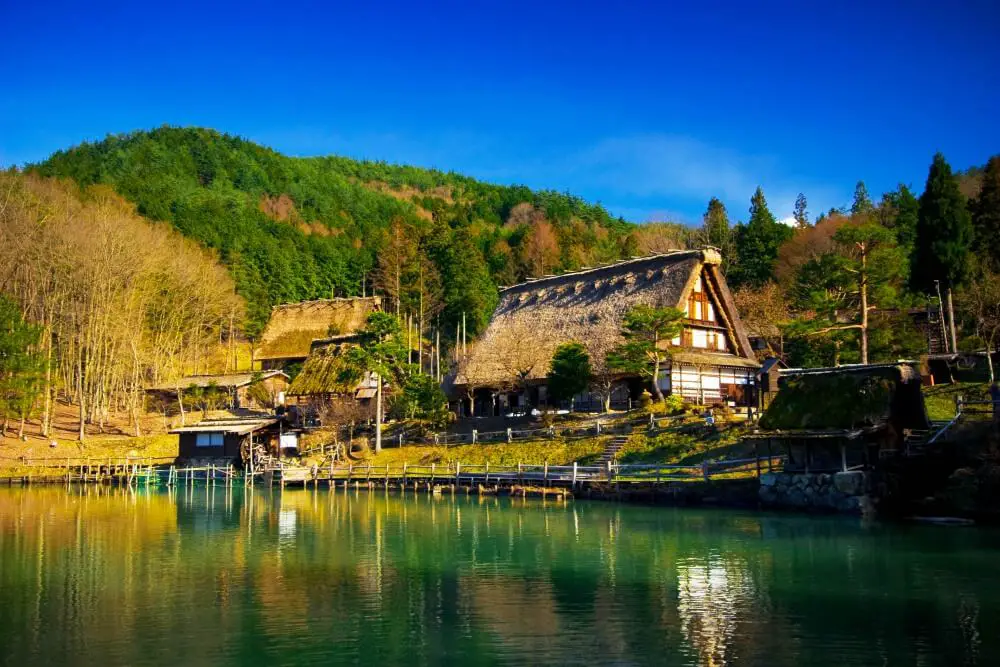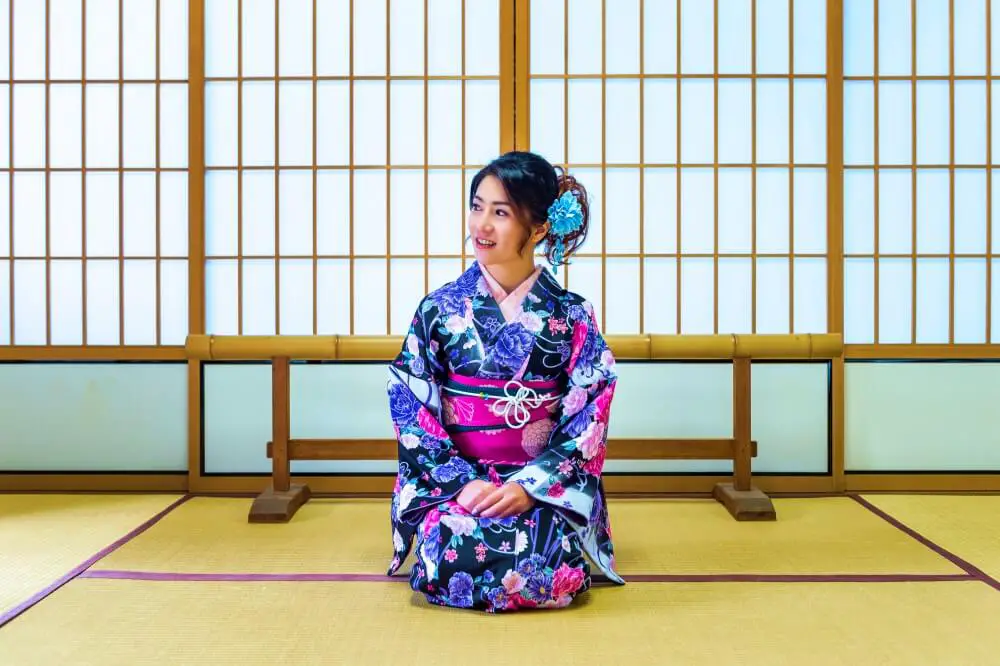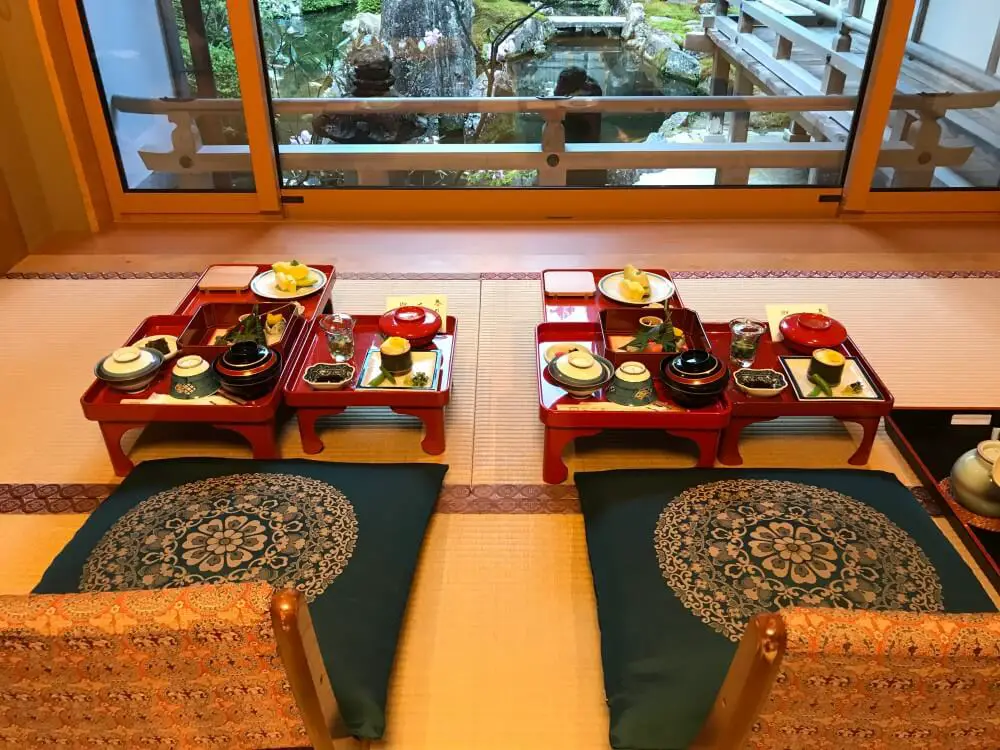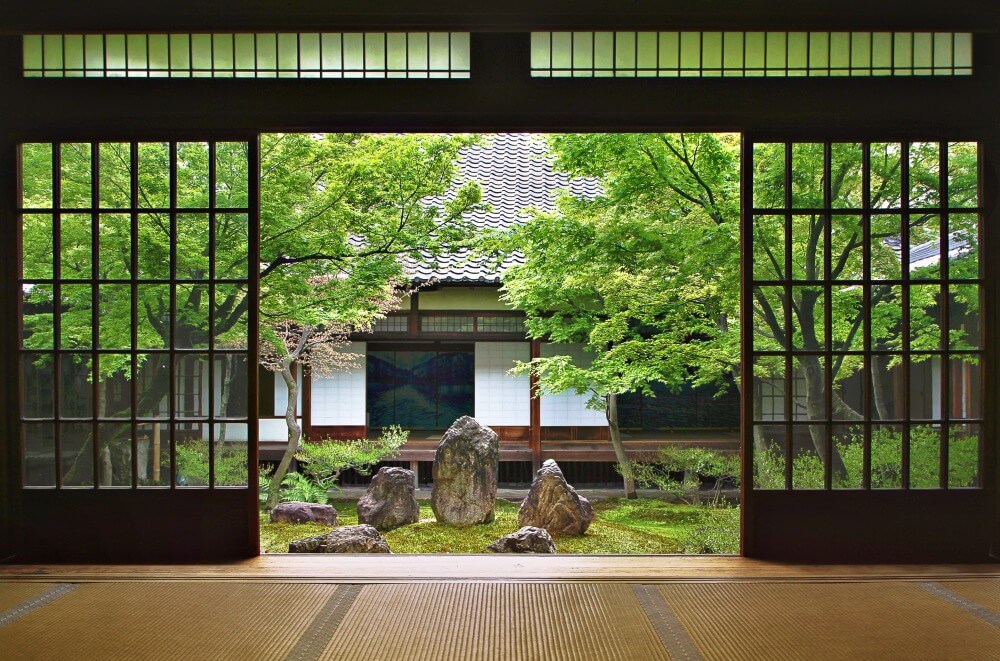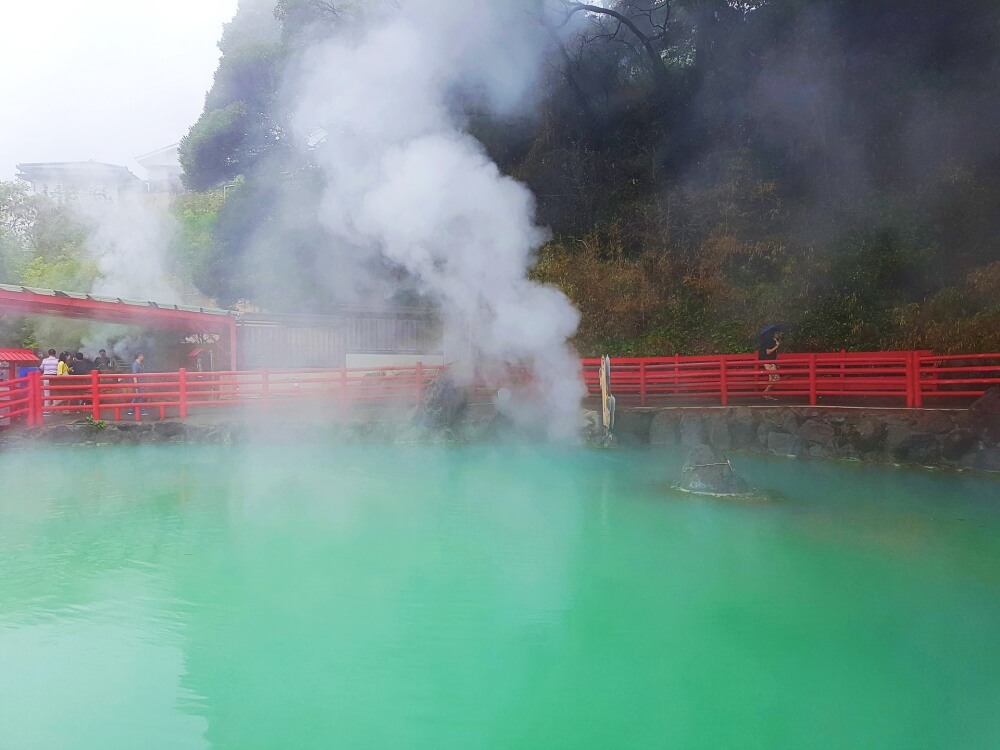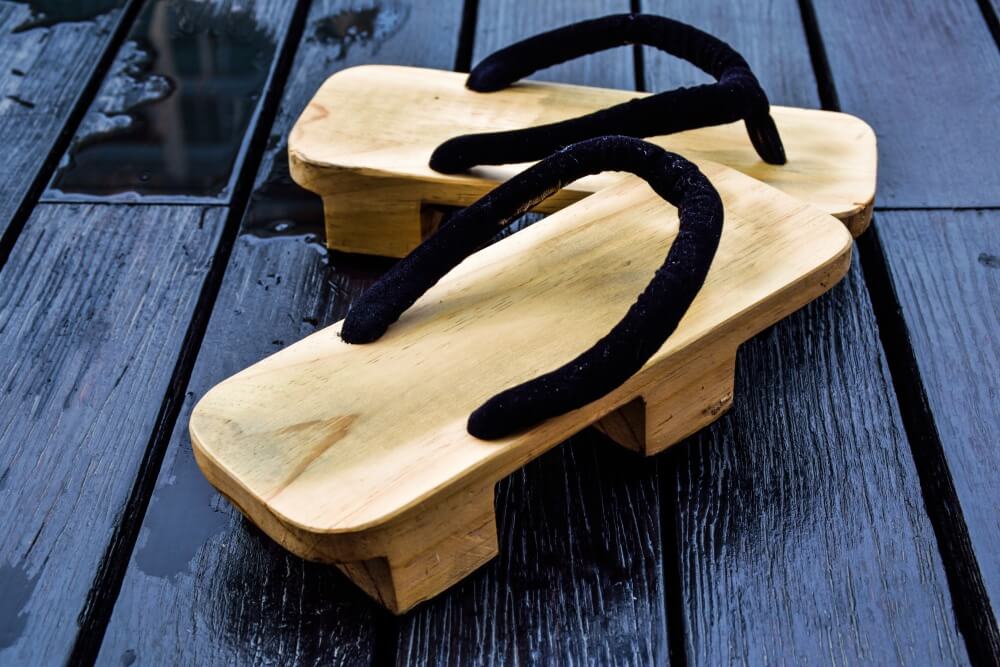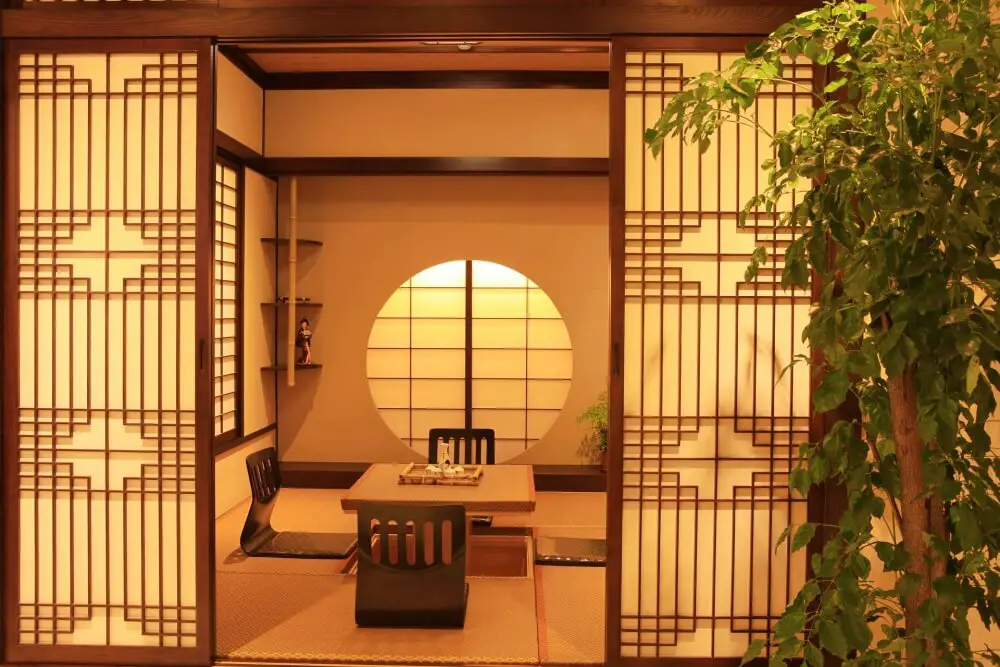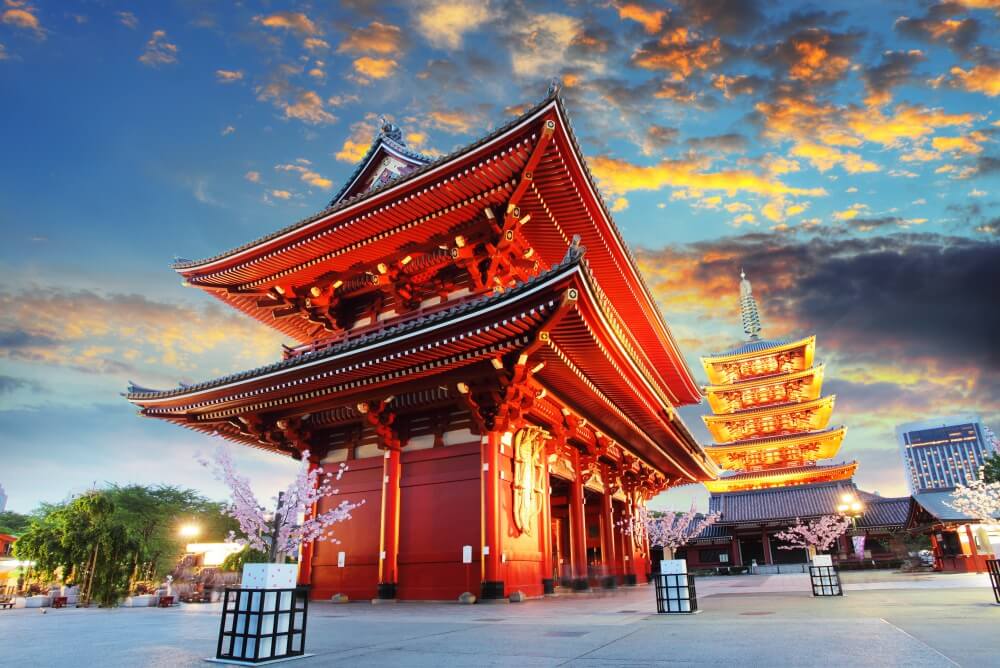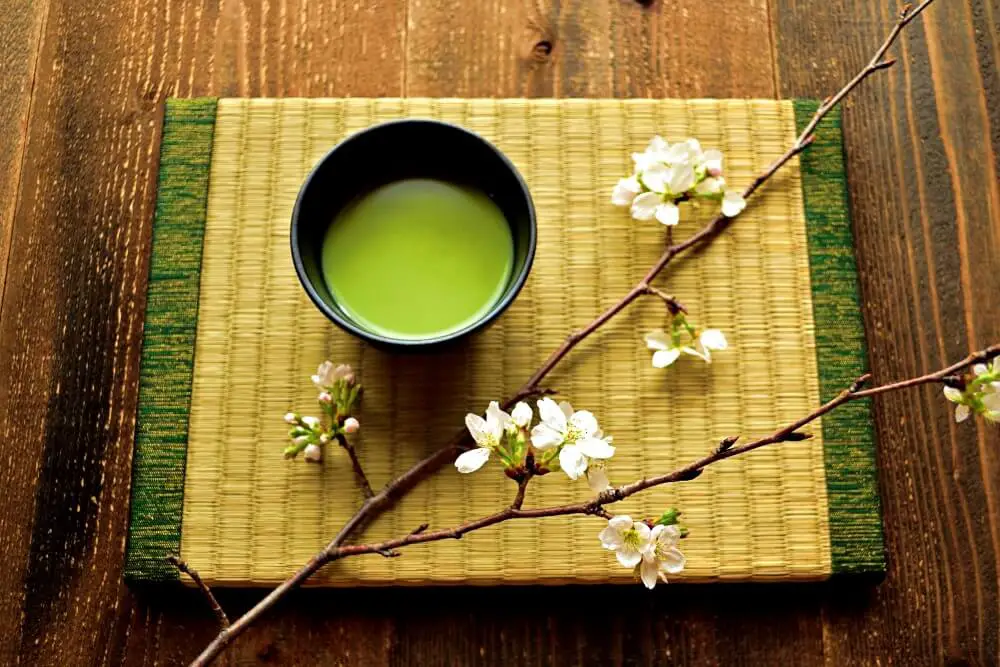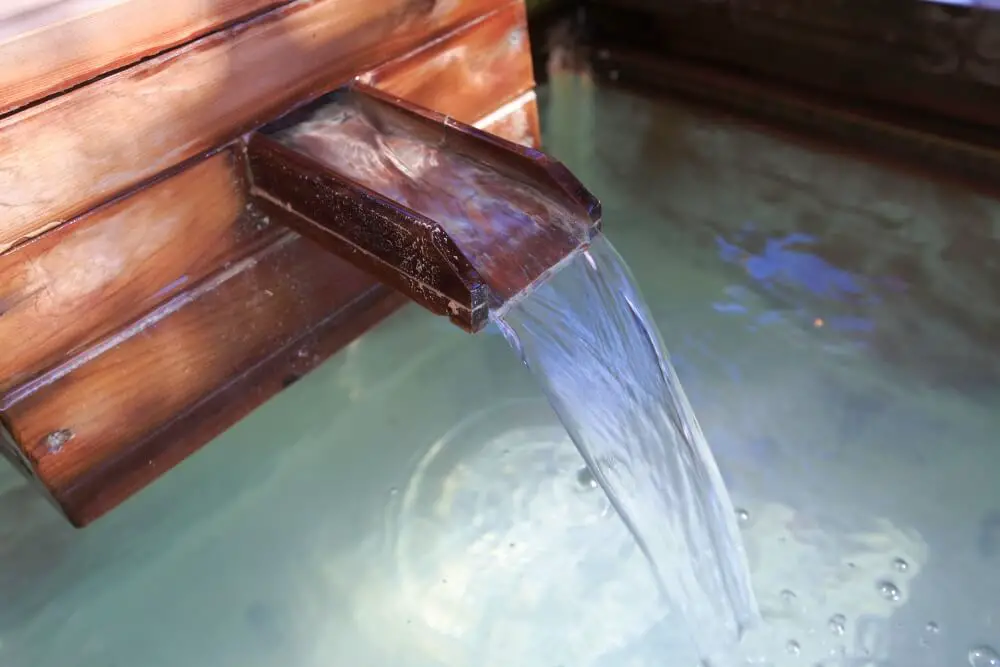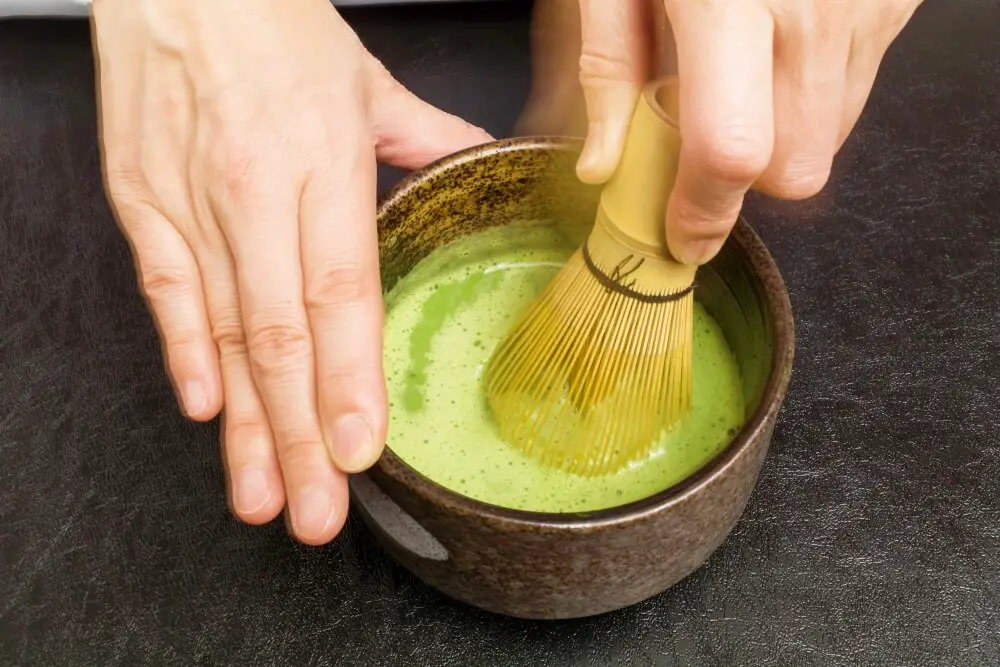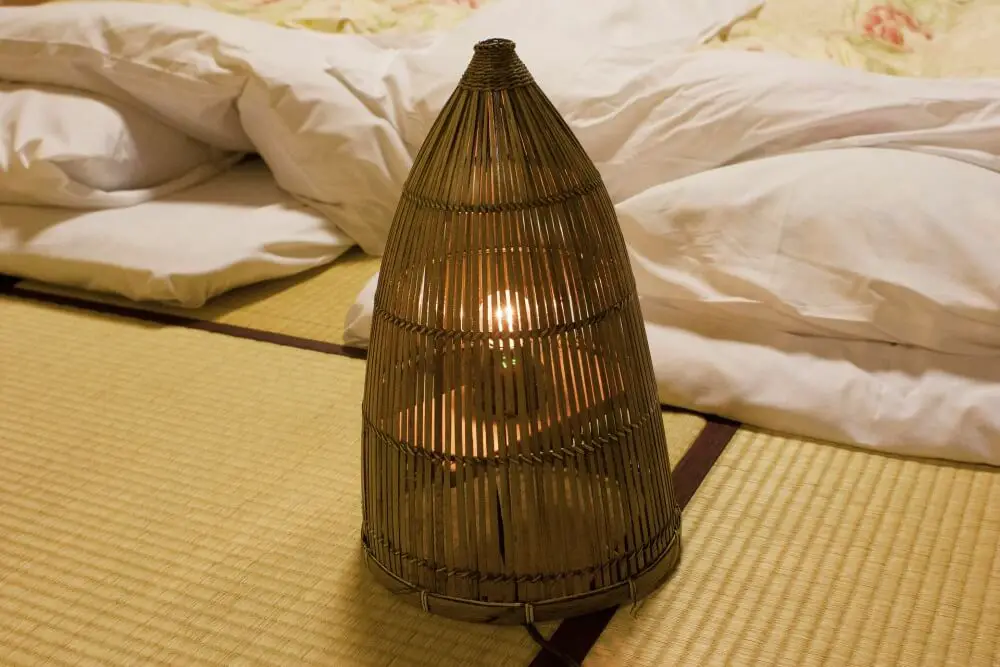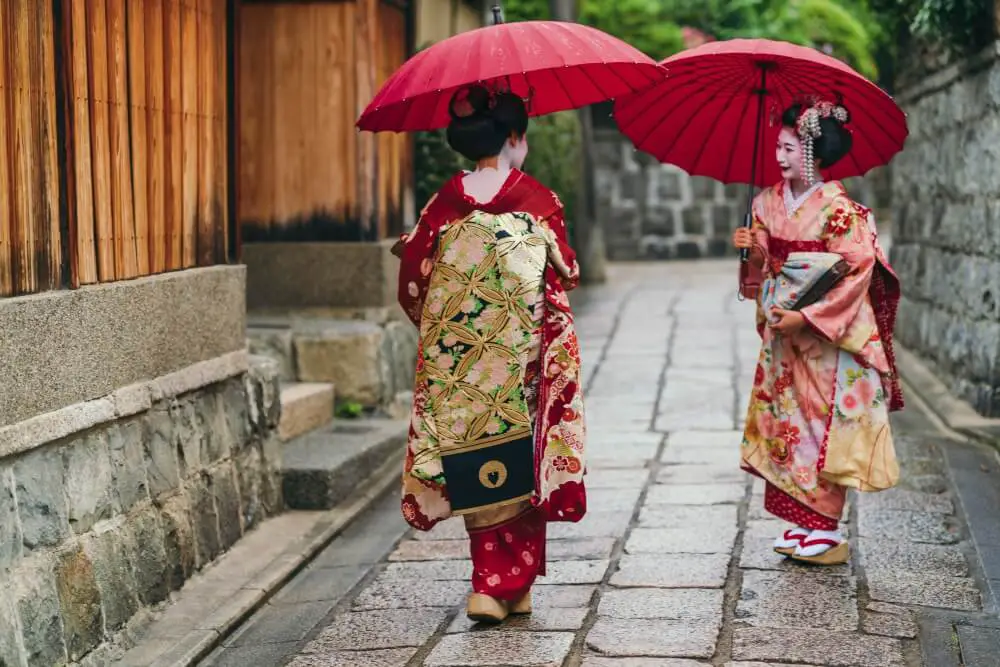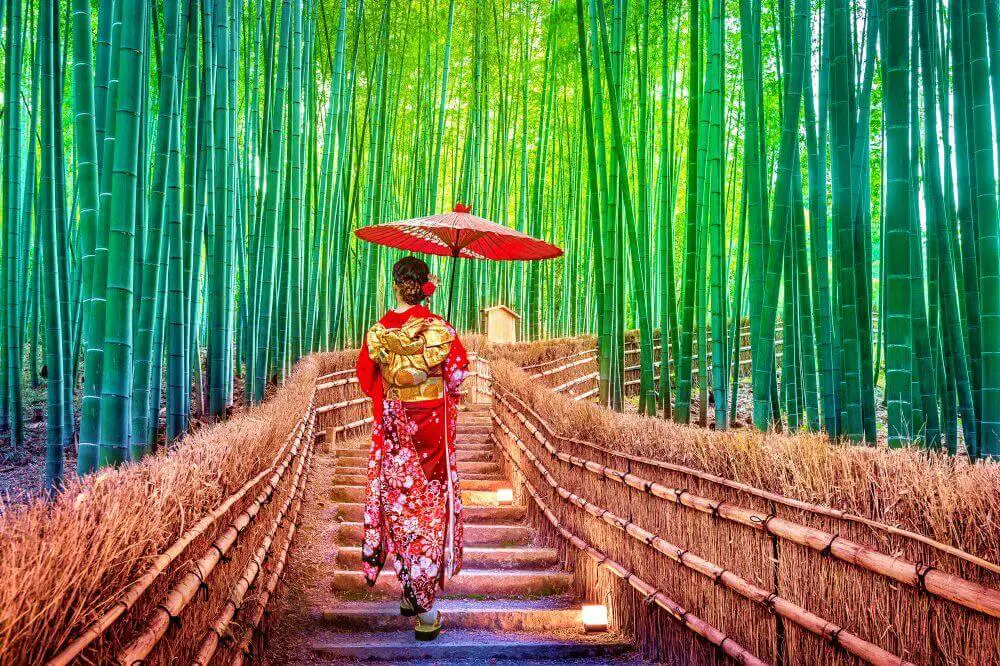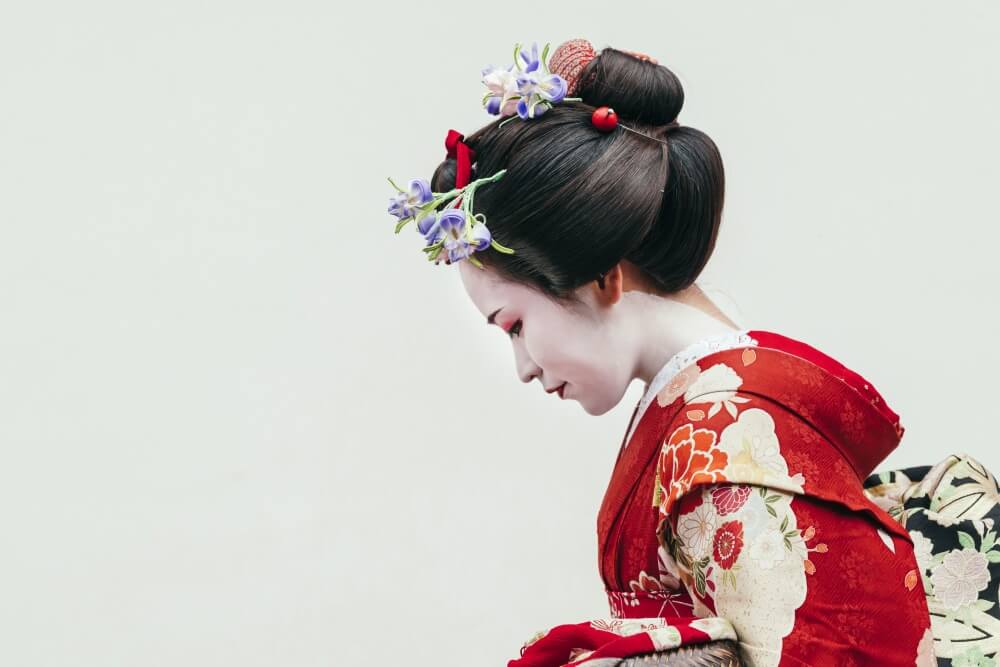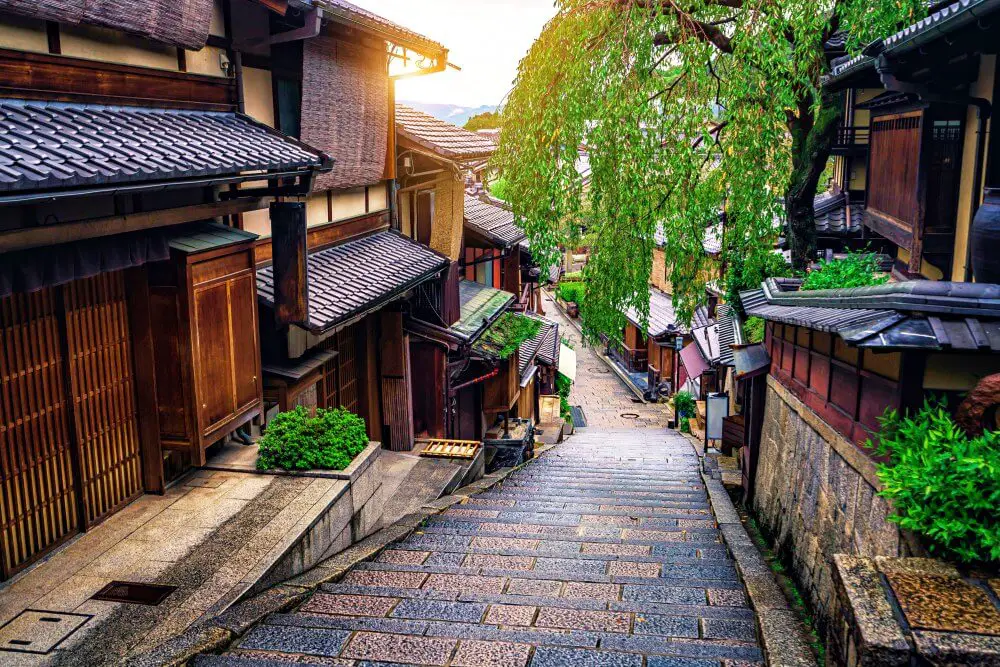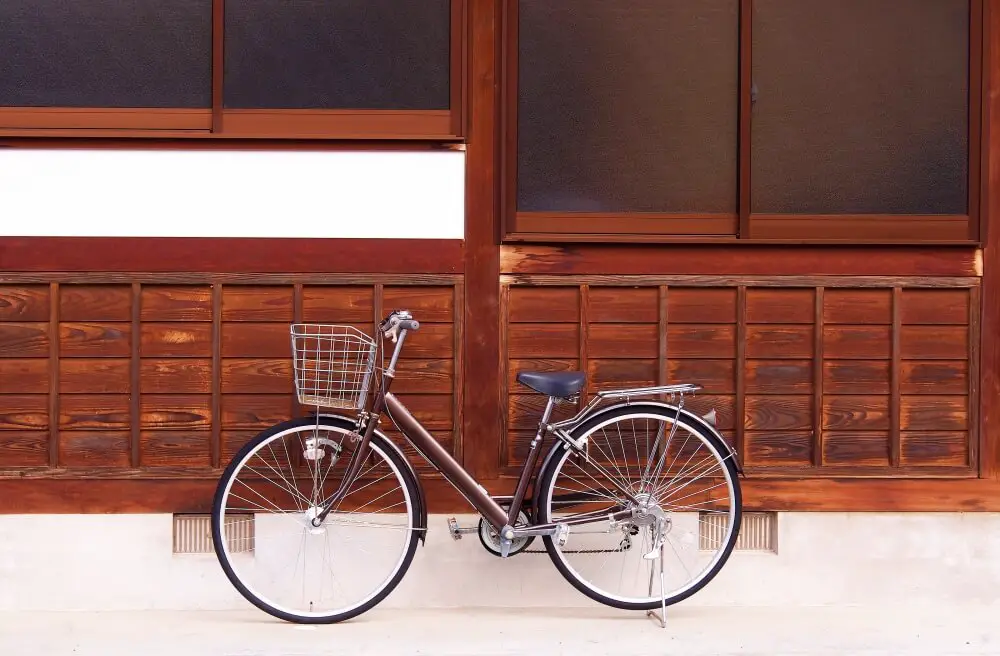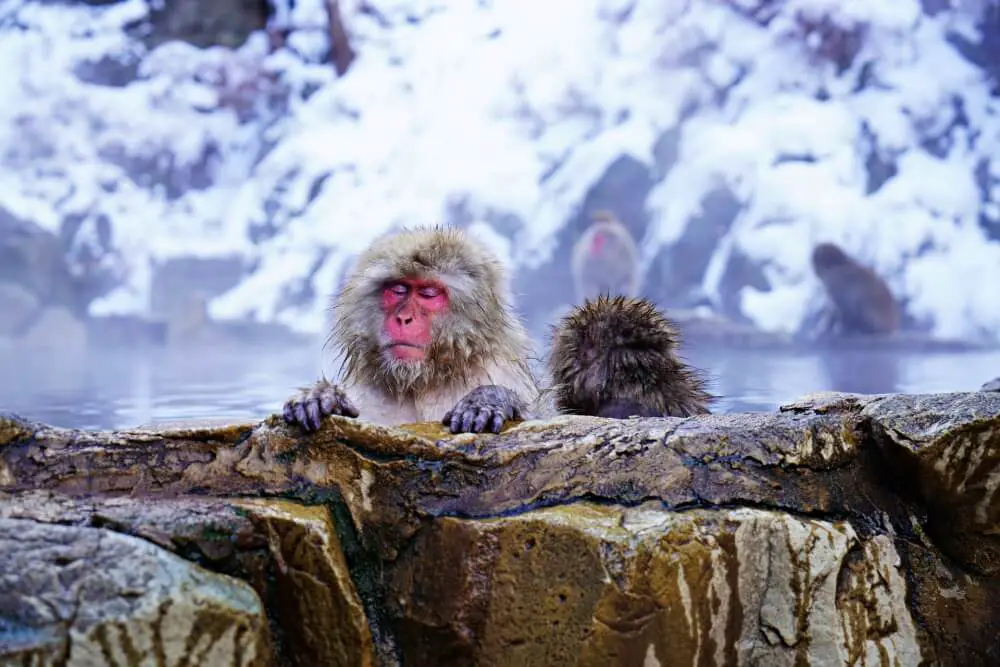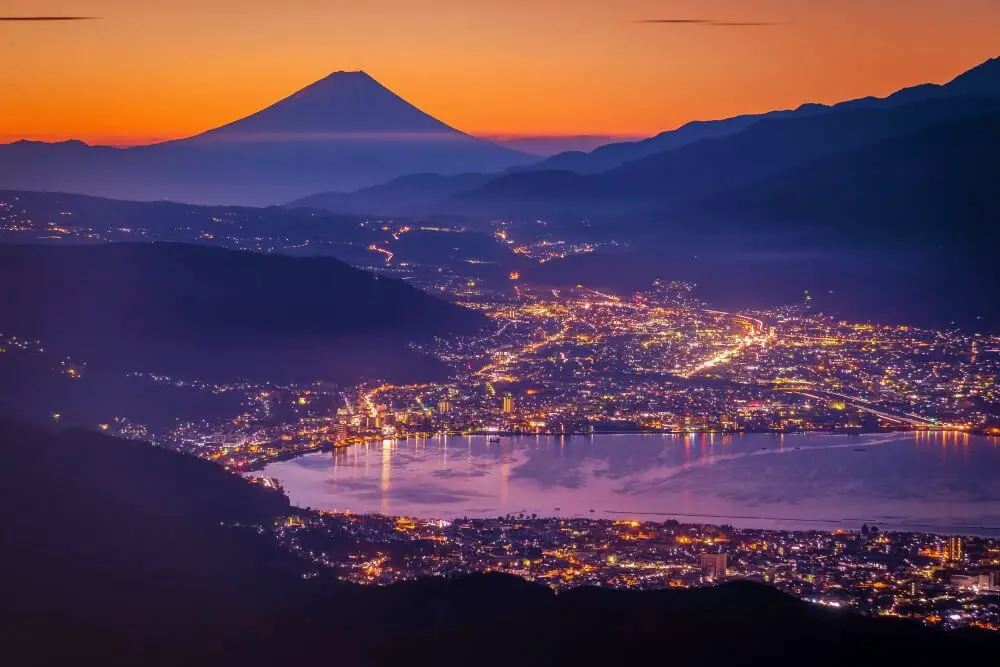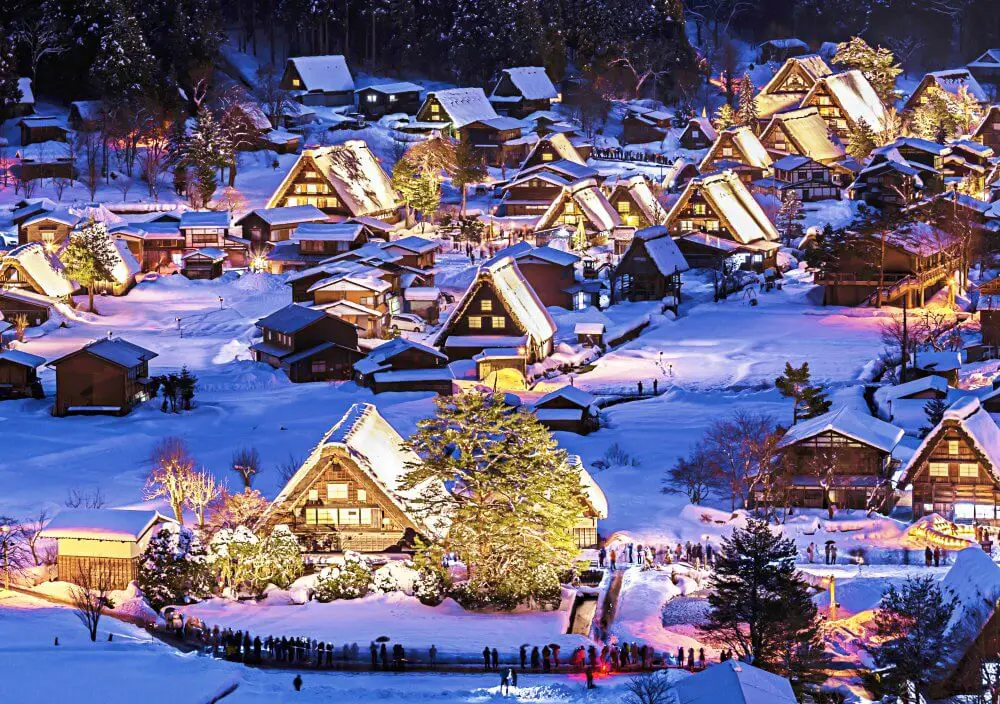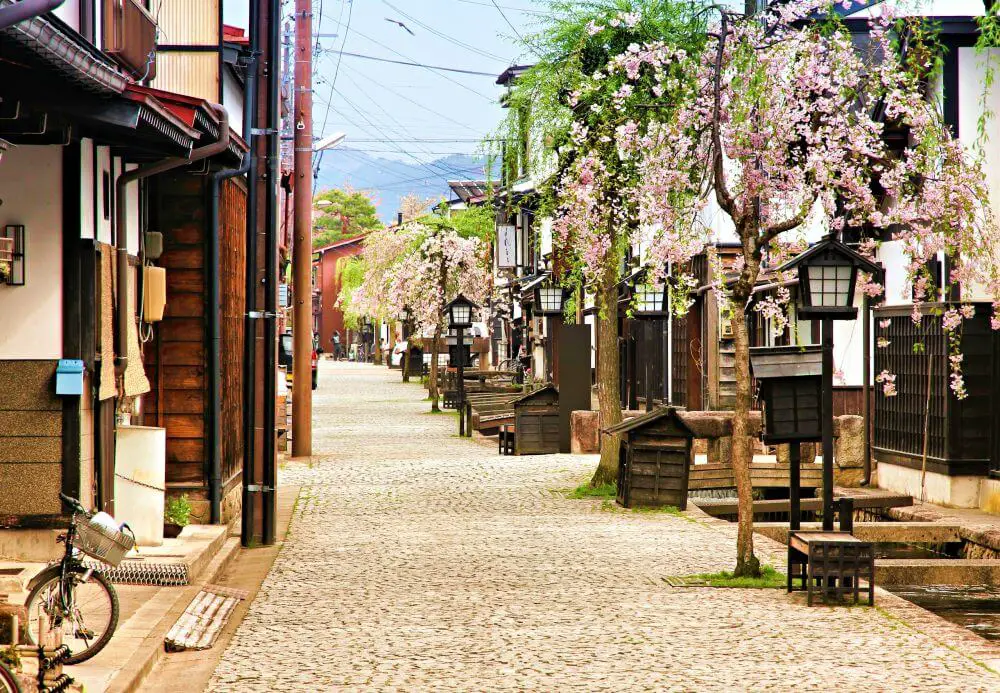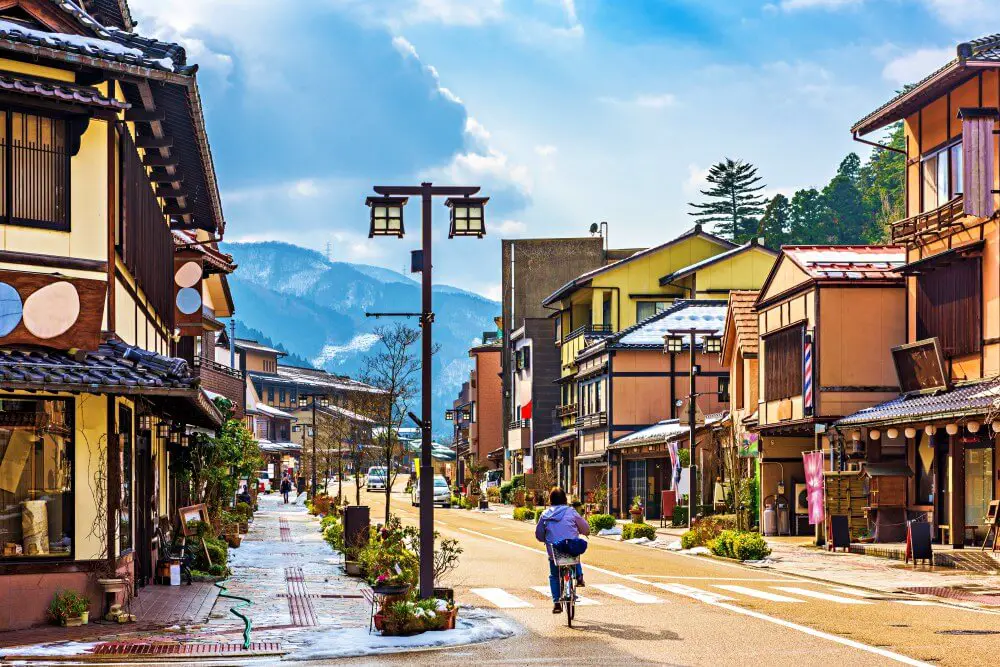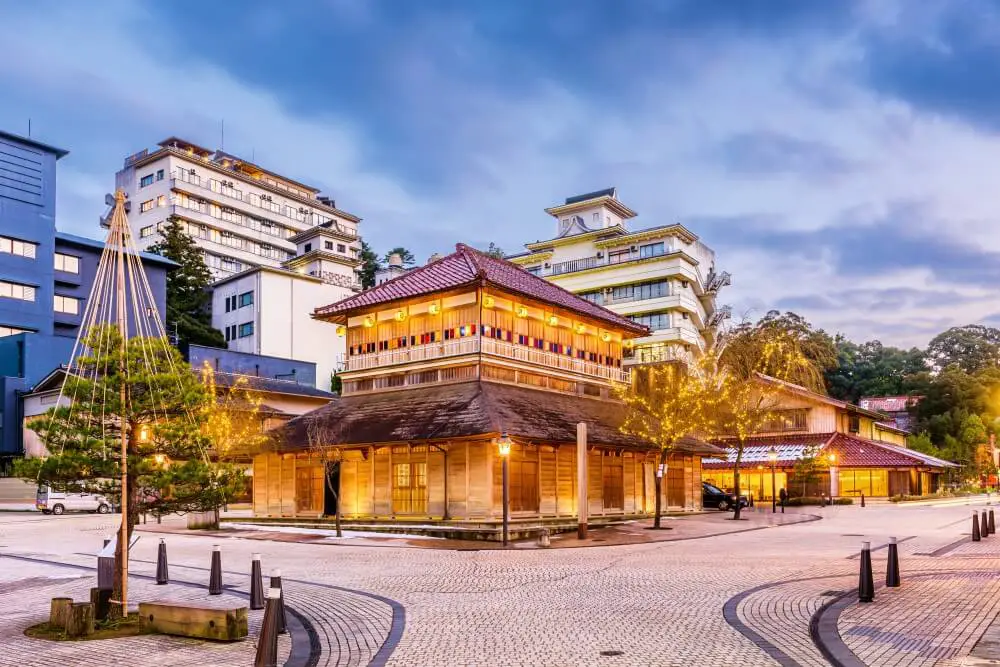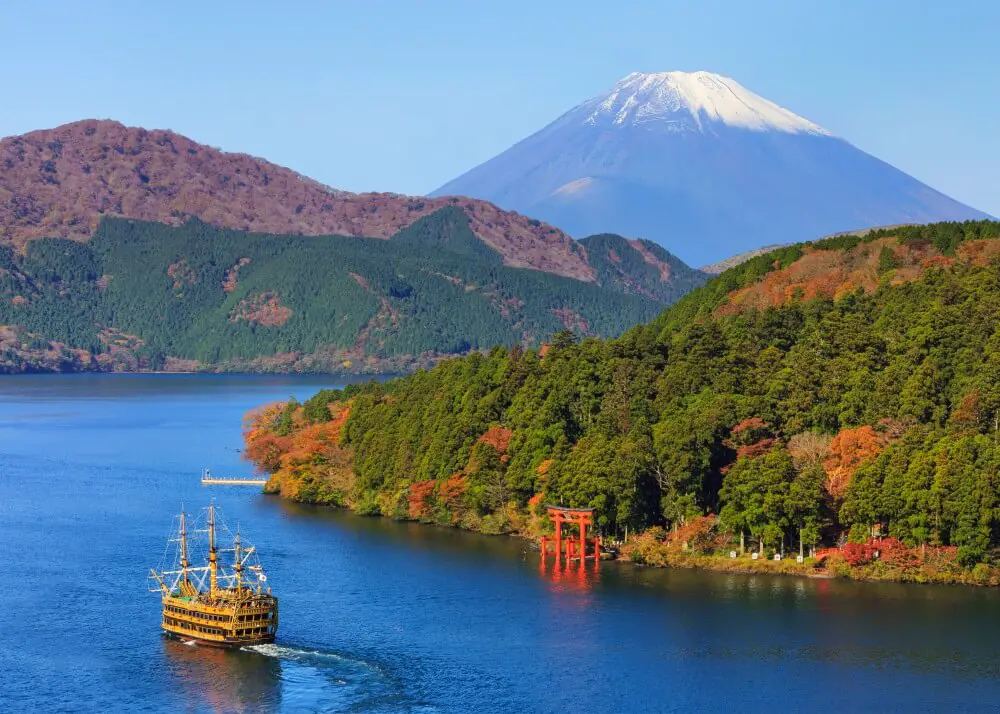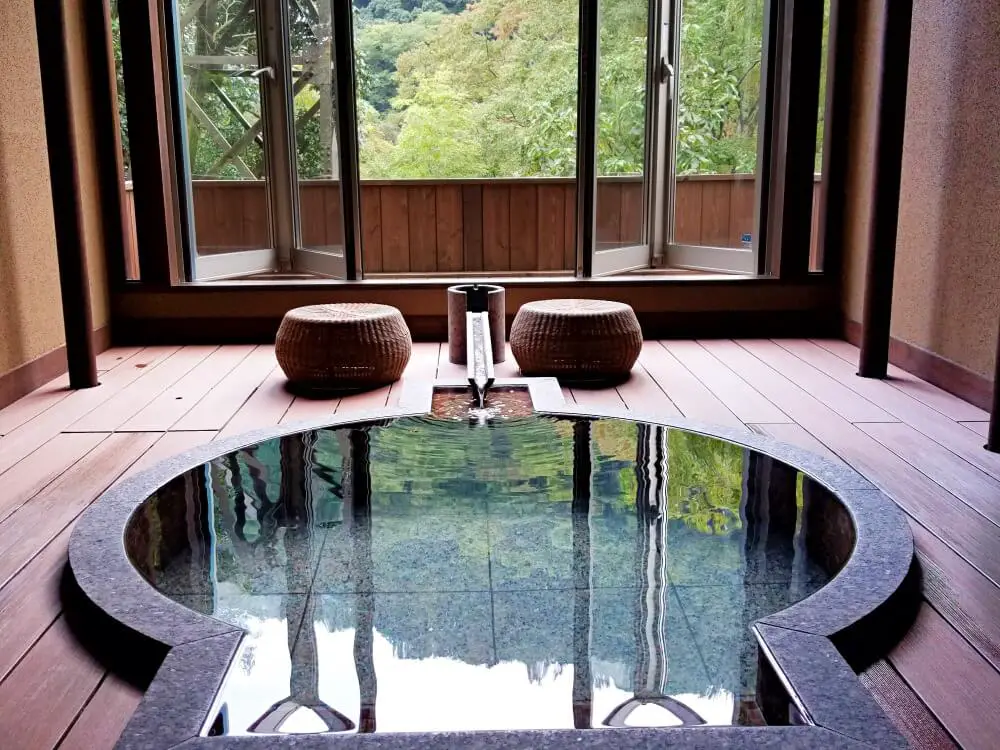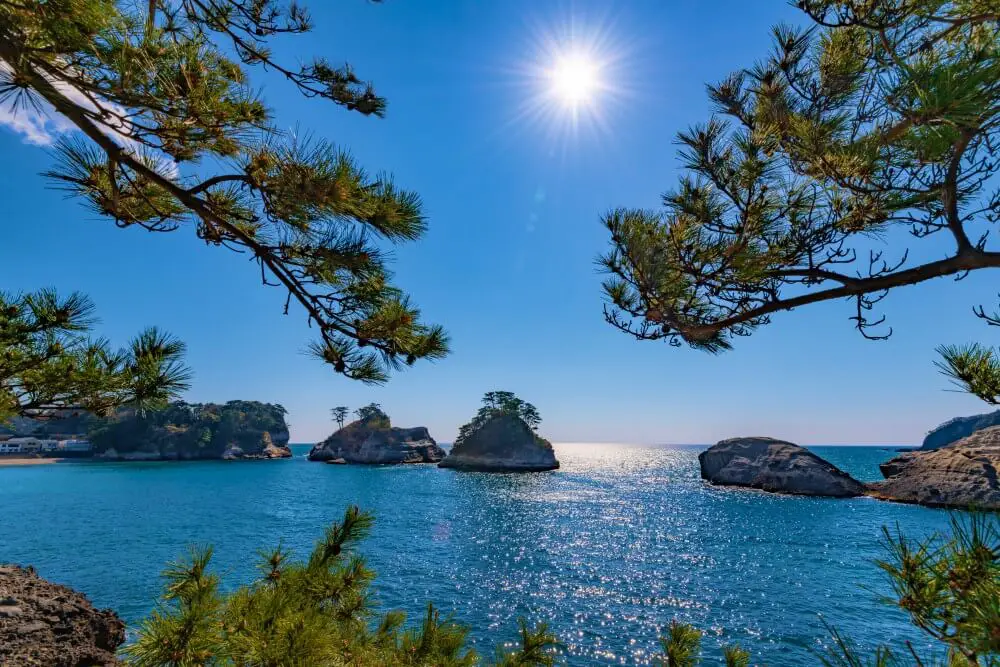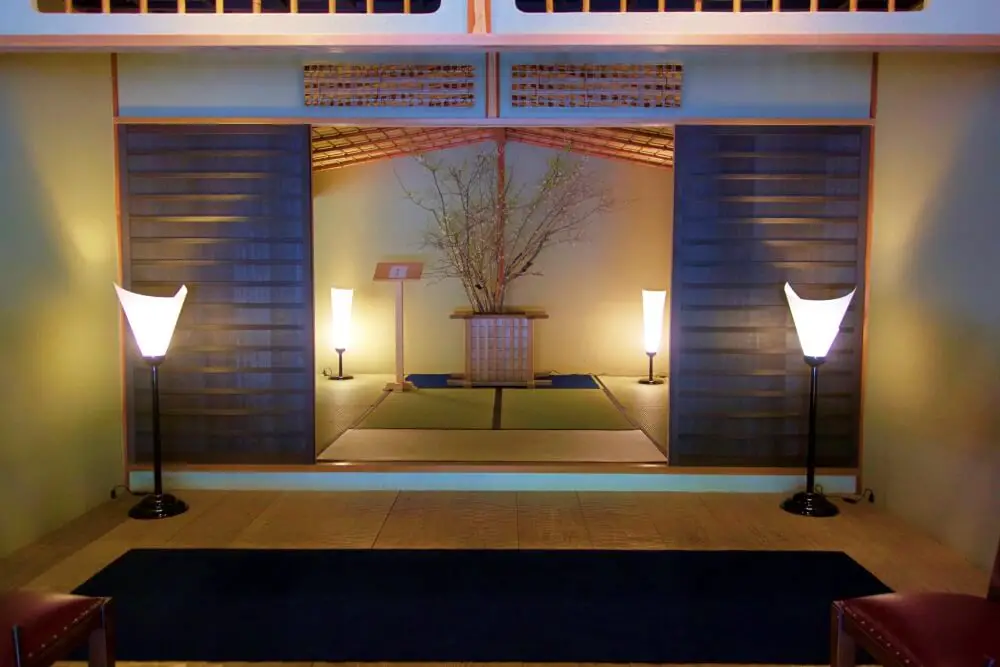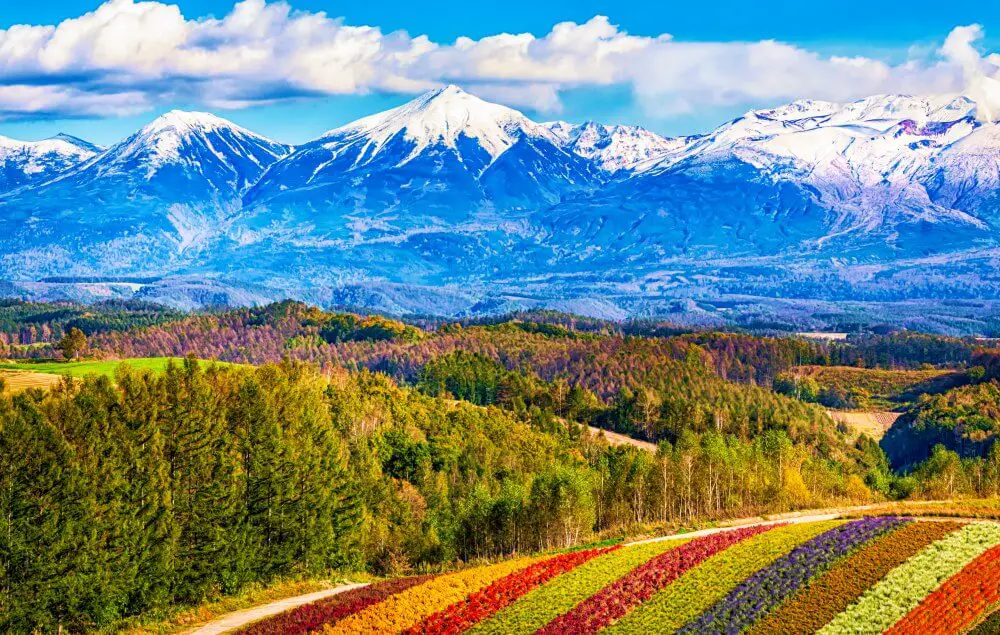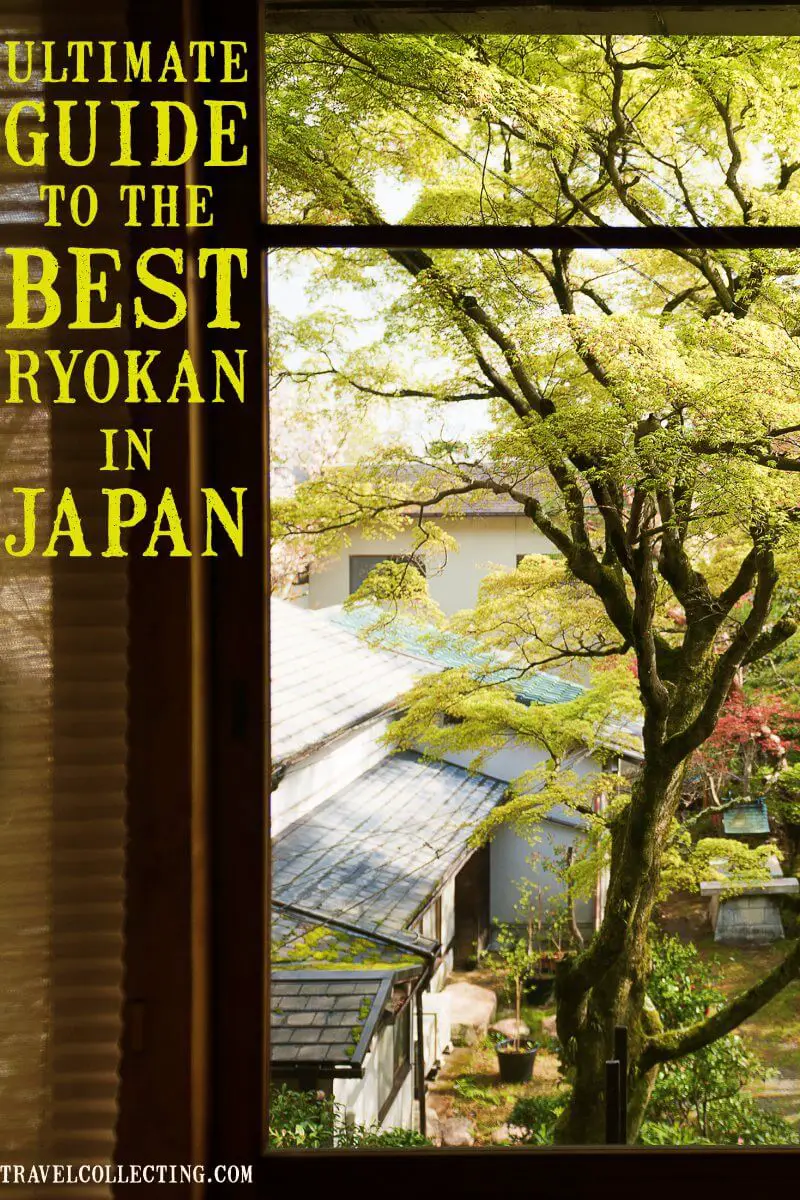So, you want to find the best ryokan in Japan? Look no further. This comprehensive guide is here to help you make the best choice for your Japanese vacation.
First, a quick overview:
What is a ryokan?
First things first. What is ‘Ryokan’ in Japanese? A ryokan is a traditional Japanese inn. It is very different from a regular western-style hotel. It is a full-on cultural experience and something I strongly recommend that every traveler to Japan do at least once.
Many people ask “Are ryokans worth it?” They aren’t cheap, but because they are a cultural experience, as well as somewhere to stay and have meals, I think they are – for one night at least.
Check out my Complete Guide to Staying in a Traditional Japanese Guesthouse here so that you know exactly what to expect.
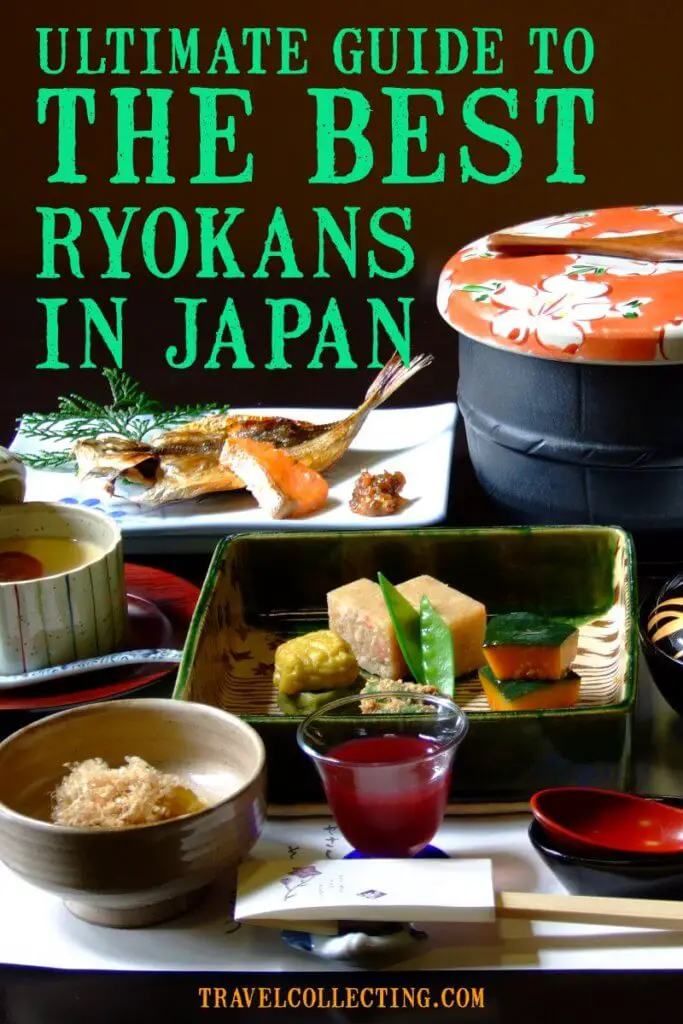
Please note that some of the links below may be affiliate links. If you make a purchase through these links, I earn a small commission at no additional cost to you. Read my Disclaimer for more information.
The Best Ryokan in Japan
We’re going to look at exactly what a ryokan is, what to look for, what effects the quality of your stay, etc. but let’s kill the suspense right now. What’s the best ryokan in Japan?
Based on all of the criteria discussed below, the top ryokan in Japan is …. drum roll … Chikusenso Mt. Zao Onsen Resort & Spa in Tohoku, the northern part of Japan. It’s a five-star luxury ryokan with not one but six public onsen, plus private onsen in each of the rooms, and a gym, spa and a rooftop lounge with a zen garden. A full kaiseki meal is available.
It has received a near-perfect guest rating on multiple hotel booking sites – and they speak English. It checks every box!
My second choice and the best traditional ryokan in the mid-price range is Nakaodaira Ryokan in Takayama. It’s a three-star ryokan with just six rooms – and six onsen – in a great location.
It is run by a super friendly and helpful English-speaking couple, the location near Takayama is great and the food is simple, delicious local and seasonal fare. The price is very reasonable and, again, it has a near-perfect guest rating on multiple hotel booking sites.
THE VERDICT: Comparison Guide to the Best Ryokan in Japan
I am going to break down what to look for and describe in detail the top ryokan in different areas of Japan, but for those who want a quick summary right now, here are my top choices.
PRICE:
$ Less than $100/ night
$$ $101 – $250/ night
$$$ $251-$500/ night
$$$$ $501-$1,000/ night
$$$$$ $1,001+/ night
The Best Luxury Ryokan in Japan
Staying in a ryokan is not cheap, but it is a unique cultural experience that is worth the splurge if you can afford it. At the high end, luxury ryokan have all the bells and whistles.
My top ten best luxury ryokan, Japan are:
[table id=60 /]
The Best Traditional Ryokan in Japan
The best ryokan Japan has, for me anyway, are the really traditional ones. They are not for everyone, but they are a great way to immerse yourself in traditional Japanese culture.
To qualify as traditional, they must:
- have fewer than 30 rooms
- be family run
- have at least one shared onsen (hot springs bath)
- serve a kaiseki meal
- provide you with yukata to wear
- offer a Japanese breakfast (though a western-style breakfast may also be served); and
- have traditional Japanese rooms with futons on tatami floors (though western-style rooms may also be available).
Where is the best onsen in Japan?
Because these all have onsen, they are also my pick for the best onsen ryokan in Japan.
We’ll look in more detail at each of them below, but here is a quick overview of my pick for the best traditional ryokan in Japan.
[table id=61 /]
THE GUIDE: How to choose the best ryokan
Staying in a ryokan is one of the top things to do in Japan, so when you visit Japan, I strongly recommend that you stay in a ryokan at least one night.
I would carve a couple of days at least out of your Japan itinerary to get out of the cities and head to an onsen town. Nothing beats relaxing in a hot spring and walking around town in your yukata.
In this guide, I’m going to compare top ryokan in different price brackets, so I will look at luxury onsen ryokans, but also the best budget ryokan in Japan.
I will also give a breakdown of things to consider when choosing a ryokan and take a look at the top – rated ryokan in different areas around the country, broken down by key areas. Ryokan are scattered throughout Japan, of course, but they tend to be more common in major cities and around hot springs.
Before we start, a quick word on grammar – Japanese grammar doesn’t have plurals, so I always use “ryokan” and “onsen” for one or for many, in keeping with Japanese grammar rules (but you can also use the plural version “ryokans” and “onsens” in English).
Now, let’s break it down…
Why you should stay in a ryokan
Staying in a ryokan is not cheap, but if you splurge on one thing when you visit Japan, it should be this. Even just one night in a luxury ryokan in Japan will be an experience that will stay with you forever.
You will share a popular traditional Japanese pastime, enjoy some of the best food you will eat in Japan, and sleep the way Japanese people have for centuries. And usually in an incredibly beautiful setting.
What to expect when staying at a ryokan
To enjoy a ryokan, you need to know exactly what to expect. Most negative reviews online are due to mismatched expectations.
If you expect and fully embrace the ryokan experience then you will love it. If you expect things to work in a similar way to a western-style hotel, then you will most likely be disappointed. This is true even in very high-end ryokan.
Some things to expect:
- you WILL need to take off your shoes.
- the meals WILL be served at set (or limited) times.
- you WILL bathe naked if there is a shared onsen (some ryokan do have private onsen).
- you WILL need to sit on the floor to eat (in most ryokan; if this doesn’t sound appealing, make sure you book one that has a western-style restaurant).
- you WILL sleep on a thin futon on the floor (unless you book a Western-style room, which are available in some ryokan).
- staff WILL come into the room to set up for dinner, put out your futon, clear things away, etc.
For the full lowdown on exactly what will happen when you stay at a traditional ryokan, check out my Complete Guide to Ryokan in Japan. There you will learn what will happen when you arrive; what the room will be like; what to wear; what food you will eat and where; where and how you will bathe; and much more. When you’ve read it, come back.
In this guide, we will look at how to choose the best ryokan in Japan and my recommendations for the top ryokan in Japan in key areas around the country.
Types of ryokan
As you read all of the descriptions of top ryokan in Japan below, you will notice that there are a few similarities and differences.
Traditional ryokan are usually small (fewer than thirty rooms) and family-owned and run. They follow all of the ryokan traditions and are sometimes seen as somewhat rigid by westerners used to more flexibility in places they stay. This is the most ‘authentic’ cultural experience, in my opinion.
Hotel-style ryokan (my term), are large hotels with Japanese-style rooms. They usually have western style rooms also. They may well have onsen, though these are often regular hot water, not mineral spring water.
The luxury hotels of this type have great service and amenities similar to a five-star western-style hotel, and the budget hotels have few amenities that more traditional ryokan have.
Modern ryokan are in modern building, often beautifully and stylishly designed, and observe many ryokan traditions, despite their modernity. They tend to be more luxury hotels.
Onsen ryokan (traditional onsen hotel) are exactly what they sound like – ryokan with onsen in them. Most ryokan fit into this category anyway, but it is a useful way to categorize them if visiting an onsen is your main reason for staying in the ryokan in the first place (which is very common).
Onsen towns usually have public onsen that anyone can go to, but ryokan onsen are typically only for guests, and usually have water that comes from the same springs, so it can be a more comfortable experience.
How to choose the best ryokan
There are some basic things to consider when choosing a ryokan in Japan. The best thing is to look at all of these factors and then make a choice that works for you. I’ve taken the legwork out of this for you and compiled this information for you.
The basic things to consider when choosing a ryokan:
- Official quality: Star rating
- Actual quality of experience: Guest ratings
- Location
- Price
Additional considerations
Is English spoken? It makes life much easier if it is, even a little. This used to be rare, but is increasingly common. Obviously if you speak Japanese, this won’t matter.
Is it completely traditional, or do they also have some western-style rooms? I personally prefer a fully-traditional ryokan, but if sleeping on a futon on the floor and sitting on legless chairs at low tables is not your thing, then you will want a western-style room. At many ryokan these days, there are both and you can still have the rest of the ryokan experience.
Do they have an onsen (hot springs)? Most ryokan are based around hot springs; however, in Tokyo especially, this is not common.
Is the bath private or shared (most common)? You need to decide what you prefer. If you are a couple on a romantic vacation, having communal onsen with separate ones for men and women may not be the way you want to spend your time. Many high end ryokan do also have private baths in the rooms, and a few have mixed-gender communal baths.
Are dinner and breakfast included? Traditionally, ryokan include these in the price, but many now have separate meal packages. Check, too, whether meals are served in your room, a private dining room, a regular restaurant or if you have a choice.
Is the kaiseki dinner top notch? I have listed any grumblings on guest reviews in my summaries below. Most ryokan have really great kaiseki meals, though if you don’t like Japanese food (and especially seafood), this may not be something you want to pay for, since they are not cheap. Most ryokan will accommodate vegetarians if you give them advance notice, but not all of them.
Is the breakfast Japanese only, or is there a western option? Japanese breakfast is usually rice, fish and miso soup. If this doesn’t sound appealing, check before you book if a western-style breakfast is available. Many ryokan that have lots of foreigners stay with them provide this option these days.
Some provide only a Japanese breakfast on your first morning, but if you stay longer they will have a western-style breakfast option on subsequent days. It’s good to know your options in advance.
Are there set meal times? This is very common in ryokans. If this doesn’t suit your plans, check in advance.
What is your budget? Ryokan tend to be expensive, especially when you include the kaiseki meal, but they do come in all price ranges. I have included some budget or mid-range options that have great reviews.
When will you arrive/ depart? Especially if you are staying one night only, you will want to make sure that you don’t arrive too late, as you will want time to enjoy the meal and the hot springs. Keep in mind too that ryokan tend to have inflexible check-in and check-out times.
Try to arrange your plans so that you don’t have to leave too early the next morning and miss breakfast (but also not too late, as check out time is usually around 10:00am).
How many nights will you stay in the ryokan? If this is a splurge for you, one night will be enough to give you the ryokan experience. However, staying a couple of nights or more will allow you to relax and really soak it all up. Often a kaiseki meal is served on your first evening and other dinner options are available subsequent nights.
If you stay more than three nights, you MAY notice the meals start to repeat themselves. Again, it is worth checking in advance if you are staying longer than a couple of nights.
What is there to do in the area? Often there is not much to do except enjoy the ryokan/ onsen (the ryokan IS the destination). However, some ryokan are located in areas with great hiking, skiing, or even sightseeing.
Location: Popular places in Japan for ryokans
Soaking in hot springs is incredibly popular in Japan and small towns exist around hot springs purely for this purpose. They are often in the mountains, so the scenery is also breathtaking in many of them.
As I mentioned at the beginning, ryokan are most popular in these onsen towns, and I think that an onsen town is the best place for ryokan in Japan. The towns tend to be small and cute, with lots of wooden houses, souvenir shops, often a small river and trees.
Walking around town in your yukata on the way to an onsen is a unique experience in Japan you should have, which is why I think that an onsen area is the best place to stay in a ryokan in Japan!
So, what’s the best area to stay in Japan? Other than onsen towns, the two major cities for ryokan are Tokyo and Kyoto. Tokyo actually doesn’t have that many, but chances are that you will visit Tokyo, so I’m including them here. Kyoto, which is much more traditional, has more (and, in my opinion, better) ryokan to offer.
Where is the best onsen in Japan? That’s difficult to say, because there are so many great ones, but if you are able to fit the southern island of Kyushu into your itinerary, I would head to Beppu.
Let’s look at the best of the best place to stay in ryokan in Japan by major areas.
THE LOWDOWN: Best ryokan in Japan by region
The Best Ryokan in Tokyo, Japan
There is no city quite like Tokyo, and it is easy to spend several days (or weeks) there. Walk across the busiest pedestrian crossing in the world, Shibuya Crossing; step back in time at the beautiful Senso-ji Temple, Meiji Shrine and Imperial Palace; climb up Tokyo Sky Tree and Tokyo Tower; enjoy the offbeat at Harajuku and Yoyogi Park; shop till you drop in Roppongi and Takeshita Street… You will never be bored in Tokyo!
Ryokan in Tokyo tend to be more like hotels with Japanese style rooms than small traditional family-run inns. Here are some of the best traditional hotels in Tokyo:
PRICE:
$ Less than $100/ night
$$ $101 – $250/ night
$$$ $251-$500/ night
$$$$ $501-$1,000/ night
$$$$$ $1,001+/ night
The best luxury ryokan in Tokyo
Arguably the best ryokan Tokyo, the Hoshinoya is, like most Tokyo ryokan, a large hotel with 84 luxurious and elegant Japanese-style rooms. Western-style rooms are also available. Hoshinoya is a chain of luxury ryokan-style hotels throughout Japan, and the Tokyo one is not the only Hoshinoya hotel to make it on this best ryokan list.
The rooms are small compared with many western-style five-star hotels, though the corner rooms tend to be larger.
Meals are served in their restaurant or can be ordered through room service. In the tradition of ryokan, there are limited mealtimes. Both western and Japanese breakfasts are available.
There is a hot tub, but it is regular water, not mineral spring water. English is spoken, though it is often somewhat limited.
STAR RATING: 4.5 stars
GUEST RATING: 9.0 – 9.4
LOCATION: Nihonbashi
PRICE: $$$ – $$$$$
PROS:
◊ Very central location
CONS:
◊ No views from the rooms
GRAND PRINCE HOTEL TAKANAWA HANAKOHRO
This is a large hotel with 376 rooms in a modern building. Of these, 16 rooms have been converted to create an exclusive “ryokan” within the hotel. The ryokan bedrooms have tatami mat floors (but western beds) and there is a special lounge with Japanese activities such as origami paper folding and wearing kimono; a private spa; and a Japanese garden with over 200 cherry trees.
Although it makes it on this list because of these Japanese-style rooms and the separate facilities, it is really not a traditional ryokan experience, since they exist within a regular western-style luxury hotel. English is spoken.
STAR RATING: 4.5 stars
GUEST RATING: 9.0 – 9.4
LOCATION: Near Shinigawa Station (a 10-minute walk)
PRICE: $$ – $$$
PROS:
◊ The garden and pool.
CONS:
◊ You pay extra for the pool, sauna, etc. If you expect this, it won’t be such a negative, however.
◊ There is only limited Internet. In many traditional ryokan, there may be none and you won’t expect it; however in this large city hotel, you probably expect WiFi.
◊ Rooms are of inconsistent quality – ask for a good room.
The best mid-range ryokan in Tokyo
Like most Tokyo ryokan, this is not a small family-run inn; rather, it is a small ten-room hotel with Japanese-style rooms. It does, however, have an onsen, which you can reserve for 30 minutes at a time. Perhaps the best onsen ryokan in Tokyo in the mid-price bracket. The rooms have private bathrooms with shower/ tub combos. There is a restaurant that serves Japanese or western-style breakfast (not included in the room rate). Dinner is catered from a BBQ restaurant next door. English is spoken.
STAR RATING: 3.5 stars
GUEST RATING: 9.0 – 9.4
LOCATION: Asakusa
PRICE: $$
PROS:
◊ Location, location, location. Asakusa is one of the main areas for travelers to visit, and this ryokan is an easy walk to the sensational Senso-ji Temple and the Tokyo Sky Tree Tower.
CONS:
◊ The bath/ shower in the rooms are small (but you can book the communal onsen for private use).
◊ It can be hard to find: It’s kitty-corner from Asakusa Public Hall (Asakusa Koukaido).
◊ The rooms are small, so there is not much room for luggage storage (though some rooms have a separate sleeping/ living area – if size is a concern, book a larger room).
◊ The area (and the rooms) can be noisy.
Another small hotel with 23 Japanese- and western- (singles only) style rooms. There is a restaurant, where Japanese- and western-style breakfast is available. There are Japanese-style baths (one for men and one for women) available 700-9:00am and 4:00-11:00pm. English is spoken.
STAR RATING: 3 stars
GUEST RATING: 8.0 – 8.5
LOCATION: Asakusa
PRICE: $ – $$
PROS:
◊ Location.
◊ Nice views from the baths.
CONS:
◊ Owner can be rude.
◊ Some rooms are very small.
◊ Patchy cleanliness.
◊ There is a policy that you can’t be in your room between 10.30am and 3:00pm so they can clean them. I’ve never encountered this outside of a youth hostel before.
◊ There is an 11:00pm curfew – not great if you want to party in Tokyo.
This is a popular mid-range choice with 20 individually-decorated rooms. Although there is no onsen, all rooms have private bathrooms, some with semi-open-air tubs. Japanese and western-style breakfast is available and is included in the price. The staff is very friendly and helpful and English is spoken.
STAR RATING: 3 stars
GUEST RATING: 8.5 – 8.9
LOCATION: Shinjuku
PRICE: $$ – $$$
PROS:
◊ Rooms are pretty big by Japanese standards.
◊ Rooms have baths, some (semi) outdoors.
CONS:
◊ Location in the suburbs (but it’s only a 5-minute walk from the subway).
◊ Some rooms are noisy.
Another simple hotel with basic ryokan amenities. There are low beds (not futons) in all of the 22 rooms, which makes this a little less authentic, though they all also have hinoki cypress wood bathtubs. There is a small bar area. (Limited) English is spoken.
STAR RATING: 3 stars
GUEST RATING: 8.5 – 8.9
LOCATION: Adachi
PRICE: $$ – $$$
PROS:
◊ Cypress wood bathtubs in the rooms.
◊ The bathrooms have fancy toilets with heated seats (really full-on modern toilets in Japan are works of technical art, I kid you not!)
CONS:
◊ Can be noisy.
◊ It’s a bit away from the center of Tokyo (though only a 10-minute walk from Gottano station).
6 non-smoking traditional Japanese tatami mat rooms in a modern building. English is spoken.
STAR RATING: 3 stars
GUEST RATING: 7.5 – 7.9
LOCATION: Nihonbashi
PRICE: $$ – $$$
PROS:
◊ Convenient location.
CONS:
◊ Small shower.
◊ Staff are sometimes absent.
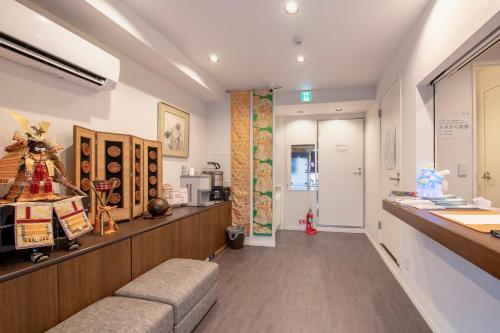
The best budget ryokan in Tokyo
Some of the best cheap ryokan in Japan are found in Tokyo. They tend to be more like hostels or simple hotels with Japanese-style rooms than full-on ryokan, but as long as you expect this, they are a way to experience a slice of Japanese culture and stay in Tokyo without breaking the bank.
A simple option with 12 smoke-free Japanese-style rooms. Breakfast (Japanese or western) is available, which you can book with the room or pay for when you stay there. There is also a bar. They also offer (for a fee) Japanese activities such as origami paper folding, calligraphy, tea ceremony and private language lessons. English is spoken.
STAR RATING: 2 stars
GUEST RATING: 8.5 – 8.9
LOCATION: Arakicho, Shinjuku
PRICE: $$
PROS:
◊ Good location close to the subway and plenty of restaurants.
◊ Friendly staff.
CONS:
◊ Small rooms.
◊ Can be noisy.
A bit more like an upscale backpackers’ hostel than a traditional ryokan, this is a solid budget option for Tokyo. It’s a modern ‘designer’ ryokan created for foreigners. They have 24 small, non-smoking Japanese-style tatami rooms. There is a nice rooftop terrace, which is a great place to hang out after a hard day’s sightseeing. There are shared bathrooms, one with a small shower and the other with a Jacuzzi and a shower. The jacuzzi has cool tile art and can be booked in 40-minute timeslots when you check in.
Meals are not included, but there is a restaurant where breakfast (Japanese and western) is served. You can book experiences such as tea ceremony or trips to the local sento (public bath) as a package when you book your room. They also have bicycle rental and laundry facilities. English is spoken.
STAR RATING: 2 stars
GUEST RATING: 8.5 – 8.9
LOCATION: Ueno, Asakusa
PRICE: $ – $$
PROS:
◊ Friendly staff.
CONS:
◊ Small rooms.
◊ Can be loud and crowded.
◊ It’s in a suburban area of Tokyo with somewhat limited restaurant options.
◊ It’s a bit of a walk from the subway (Minowa station).
This 22-room hotel was founded in 1960’s as an inn for touring musicians and even today they have a soundproof room for musicians to use! It’s kind of like a hostel, with a kitchen, a small common area, and a laundry.
STAR RATING: 2 stars
GUEST RATING: 8.5 – 8.9
LOCATION: Arakawa
PRICE: $
PROS:
◊ Economical, since you can cook and do your laundry.
CONS:
◊ Small rooms (some have wooden floors and some tatami).
The Best Ryokan in Kyoto, Japan
Kyoto is a former capital city of Japan, and is a wonderful contrast to Tokyo. Kyoto is the center of traditional Japan and is home to many beautiful temples, shrines and gardens. Most of the areas f historical interest are in Gion or on the outskirts of town. It is in Kyoto that you can see geisha and maiko (apprentice geisha), usually in the narrow streets of Gion, and sample fabulous traditional food.
You can visit the Golden Pavilion Temple (Kinkaku-ji), Silver Pavilion Temple (Ginkaku-ji) or the incredible Kiyomizu-dera Temple; walk through a tunnel of bright orange tori/ gates at Fushimi Inari-taisha in the south of Kyoto or a hallway of bamboo in Arashiyama in the west of Kyoto; quietly contemplate the raked sand and stone zen gardens at Ryōan-ji, Daisen-in or Ginkaku-ji; and wander through the moss garden set around heat-shaped pond at Saiho-ji/ Koke-dera, the Moss Temple.
No matter what you love to do, finding the best places to visit in Kyoto is easy. Knowing the best place to stay in Kyoto is a little less obvious, however. This is a great city to stay in a ryokan, so you need to know the best hotels in Kyoto, Japan. So, what are the best ryokan hotels in Kyoto?
The 10 best ryokan Kyoto has are:
The best luxury ryokan, Kyoto
The Benkei is generally considered the best ryokan in Arashiyama, if not the best onsen ryokan in Kyoto. It is in a beautiful building with traditional architecture reminiscent of antique tea houses.
The Benkei has 10 rooms with views of the mountains, the river or the garden. The rooms all vary in size and whether they include an outdoor onsen, an indoor tub (not spring water) or have no in-room bathroom.
Arashiyama onsen is one of the best onsen in Kyoto and the Benkei takes full advantage of this. The ryokan is arguably the best onsen hotel in Kyoto/ best hot spring hotel in Kyoto. It has two indoor onsen and two outdoor onsen (one each for men and women), as well as a small private tub big enough for two people that can be reserved free of charge in 45-minute time slots.
There are different packages available, including room only, or with a kaiseki meal in your room or with breakfast as well (served in their restaurant). A vegetarian kaiseki is possible if arranged in advance.
They have two banquet halls overlooking the river, but these are for large groups. The attention to detail and all of the inclusions make this one of the best traditional ryokan in Kyoto. English is spoken.
STAR RATING: 4 stars
GUEST RATING: 9.0 – 9.4
LOCATION: Arashiyama, just upstream from (west of) the famous Togetsu-kyo Bridge.
PRICE: $$$$ – $$$$$
PROS:
◊ Its location right on the Arashiyama River.
◊ Multiple onsen options make this one of the best ryokan onsen in Kyoto.
CONS:
◊ Some people complain that is looks a little “tired”.
Another contender for best hotel to stay in Kyoto. A beautiful ryokan with a main building and annex set around a lovely garden. Rooms are generally spacious by Japanese standards and you get your own room attendant. Kaiseki dinner and breakfast in your room are optional when you book. All rooms have private wooden bathtub and toilets with electric toilet seats. There is also a large public bath (not an onsen). No English is spoken.
STAR RATING: 4 stars
GUEST RATING: 9.0 – 9.4
LOCATION: Higashiyama
PRICE: $$$$
PROS:
◊ Attentive staff, a beautiful garden, and plenty of space in the suite.
◊ Tastefully decorated.
CONS:
◊ The bath is not mineral springs water.
◊ It’s next to busy street and has thin walls, so it can be noisy.
◊ Mixed reviews on the friendliness of the staff.
◊ Food gets mixed reviews.
The Hatanaka ryokan is located in Gion, the most traditional part of Kyoto, where it is common to see geisha and maiko. It is a beautiful place that provides a very traditional experience (see my guide to know what to expect!).
The 21 Japanese-style only rooms have views out on to small garden. Another candidate for the best ryokan in Kyoto with private onsen, there is a public shared bath (not mineral spring water though) as well as private baths in the rooms.
The kaiseki dinner changes with the seasons and the rice porridge in the Japanese breakfast also changes monthly. Note that on your first morning, a Japanese breakfast is the only option (because they cook it the night before). Subsequent mornings you can choose either a western or Japanese breakfast.
In addition to the usual ryokan features, there are different cultural packages that you can also buy. They have a samurai kembo show with kaiseki dinner (a performance done with samurai swords and traditional fans).
The real treat, though, and what makes this another popular choice for best ryokan to stay in Kyoto, is that you can book to have maiko (apprentice geisha) host and perform at your kaiseki dinner.
Contrary to common belief, geisha are not and never have been prostitutes. They are highly trained hostesses who entertained guests at teahouses with their conversation and singing and dancing. This is still what they do, but it is very rare for foreigners to have access to this entertainment. So, this is a real treat!
(Somewhat limited) English is spoken.
STAR RATING: 4 stars
GUEST RATING: 9.0 – 9.4
LOCATION: Gion
PRICE: $$$ – $$$$
PROS:
◊ Cultural experiences such as the samurai kembo show and maiko kaiseki.
◊ Great location.
◊ Rooms are quite large by Japanese standards.
CONS:
◊ Some rooms and bathroom need refurbishment (some reports of mold in the wooden tub).
◊ The kaiseki meal gets mixed reviews (and it isn’t cheap).
◊ The whole place is not non-smoking, so if you’re sensitive to cigarette smoke, you may smell smoke in the communal areas.
This is a modernized version of the traditional ryokan. Although it isn’t a ryokan in the traditional sense of the word – it’s a curious mix of modern hotel and old-style values and traditions – many of the ryokan traditions are observed.
There are 30 rooms, including one suite with a private garden and one room with western-style beds (all others have futons). All rooms have private bathrooms.
In addition, there are two public baths (not mineral spring onsen) – one with a jacuzzi and one with a jacuzzi and bubble bath. They alternate between men and women at different times of the day. There is a small “book corner” library and a gift store.
A traditional kaiseki dinner is available in your room (for an additional fee). There is also a banquet hall available. Japanese breakfast is available in the breakfast room on the first morning and a western breakfast option is available from the second morning onward. Breakfast is not included in the room price. (Limited) English is spoken.
STAR RATING: 4 star
GUEST RATING: 9.0 – 9.4
LOCATION: City center
PRICE: $$ – $$$
PROS:
◊ Great location just two subway stops from the JR Kyoto station.
◊ Great service.
◊ There is a welcome green tea and Japanese pancakes when you arrive.
◊ The rooms are spacious by Japanese standards.
CONS:
◊ Some of the rooms are a little noisy.
◊ The kaiseki dinner gets mixed reviews.
MOMIJIYA HONKAN and MOMIJIYA BEKKAN KAWA NO IORI
There are two Momiji-ya – the main building is Momiji-ya Honkan (AKA Takao Sanso = mountain villa), which has 14 rooms, and the “Annex” or ‘detached house’ Momiji-ya Iwori Bekkan (AKA Kawa-no-iori = hermitage), which has 8 rooms.
Momijiya Honkan is located on the top of a hill, whereas Momijiya Iwori Bekkan is down the hill right next to the river. In fact, you get to the annex by crossing the river over a footbridge. The main ryokan is nice, but the annex is nicer.
There are several temples within walking distance and there is also a hiking trail in the forest. The location makes this one of the best ryokan near Kyoto and best onsen ryokan near Kyoto.
The main building has two open baths – one outdoors and one with windows looking out onto the mountains – and the annex also has one outdoor bath. Japanese and western-style rooms are available in the annex, but there are only Japanese-style rooms in the main ‘villa’. Some rooms have private outdoor baths.
It’s possible to book the room only, but there are no restaurants nearby. The meals are seasonal and most include wagyu beef. They are served in the river terrace restaurant rather than your room. It is also possible to book a meal with maiko hostesses/ entertainment.
Both Momijiya ryokans are about 30 minutes north of Kyoto, but they have a free shuttle to the subway and JR stations.
STAR RATING: 3.5 stars
GUEST RATING: 9.0 – 9.4
LOCATION: Takao is a peaceful mountain small town in northern Kyoto, 25 minutes away from Kyoto Station.
PRICE: $$$ (Honkan) and $$$ – $$$$ (Iwori Bekkan-Annex)
PROS:
◊ All the rooms and the hot baths are facing the mountains.
◊ Spacious rooms.
◊ The annex especially has a great location next to the river.
CONS:
◊ The onsen is only a hot water bath, not hot-spring water.
◊ The WiFi is spotty.
This centrally-located ryokan has just 7 rooms, all with cypress bathtubs and western-style beds (no futons). It has a cozy library/sitting room overlooking a lovely garden with a veranda. Kaiseki dinner and Japanese breakfast are available. English is spoken.
STAR RATING: 3.5 stars
GUEST RATING: 9.5 – 9.9
LOCATION: Shimogyo, near Kyoto Station
PRICE: $$$ – $$$$
PROS:
◊ Friendly staff.
CONS:
◊ The dinner menu repeats itself after 3 days.
◊ Cleanliness has received some negative comments.
◊ Midnight curfew.
The best mid-range ryokan in Kyoto
This is one of the best Ryokan in Kyoto in the mid-range price bracket. It has a great location near the Heian Shrine. It’s in a traditional wooden 100-year-old building.
There are 13 Japanese-style rooms, and the entire ryokan was renovated and refreshed in 2010
There are two public Japanese-style baths (not onsen). Standard rooms have shared bathrooms while superior rooms have a private modular bathroom. There is also a lovely garden, which some rooms look out on.
A traditional breakfast is served, and there are many restaurants nearby. English is spoken.
STAR RATING: 2 stars
GUEST RATING: 8.5 – 8.9
LOCATION: Near Heian Shrine
PRICE: $$ – $$$
PROS:
◊ Location near some of the major sights.
◊ Breakfast and shared bath give you a traditional experience.
CONS:
◊ No western rooms.
◊ No dinner.

This is an intimate ryokan with 13 spacious Japanese -style rooms centered around a traditional stone garden, that can be seen from some rooms. In a beautiful well-maintained traditional building, this is a one of the classic family-run traditional ryokan in Kyoto. “Best place to stay in Kyoto” is a frequent comment from guests.
The spacious rooms have tatami mats and beautiful paper screens. There is a shared public bathroom (not an onsen). A homemade Japanese breakfast is available in some rooms rates (and a western breakfast can also be requested when you book). A seasonal kaiseki dinner is also available at an additional price. They also have a limited number of parking spaces available.
The entire ryokan is non-smoking. English is spoken.
STAR RATING: 2 stars
GUEST RATING: 8.0 – 8.4
LOCATION: Eastern Kyoto (near Gion)
PRICE: $$
PROS:
◊ Location. You can walk to most of the eastern Kyoto temples and the historic Gion district is nearby.
◊ Traditional stone garden
◊ Large rooms, including family rooms
CONS:
◊ Public bath is small
A loveky ryokan with several rooms of different sizes, but all with private bathrooms. There is also a shared public bath (not an onsen).
Breakfast is included and can be Japanese or western as long as you book the western breakfast in advance. A seasonal kaiseki dinner is also available.
It is within walking distance to Nijo Castle, Kyoto Palace and Nikishi Market. Bicycles are available for guests to use.
English is spoken.
STAR RATING: 2.5 stars
GUEST RATING: 9.0 – 9.5
LOCATION: City Center
PRICE: $$ – $$$
PROS:
◊ Location
CONS:
◊ Hasn’t been refurbished recently
◊ No western-style rooms
The best budget ryokan in Kyoto
The best budget ryokan in Kyoto tend to be located in the city center (whilst the best luxury hotels in Kyoto are mostly on the outer edges of the city, which is where most of the temples and shrines are).
The best affordable ryokan in Kyoto also tend to be a little more modern with fewer of the traditional ryokan extras like a kaiseki meal and onsen.
Often cited as the best value ryokan Kyoto has, this non-smoking ryokan has 7 rooms. Breakfast is included. Although there is no onsen, they provide free entrance to the nearby sento (public bath house). They provide bicycle rental. (Limited) English is spoken.
STAR RATING: 3 stars
GUEST RATING: 9.5 – 9.9
LOCATION: Shimogyo (near Kyoto JR Station)
PRICE: $$
PROS:
◊ The hotel staff are very friendly and helpful.
CONS:
◊ Small rooms and bathroom.
◊ The location isn’t the best. It’s about a 15-minute walk from Kyoto Station.
◊ Dinner is not available in the ryokan and there aren’t many restaurants in the neighboring area.
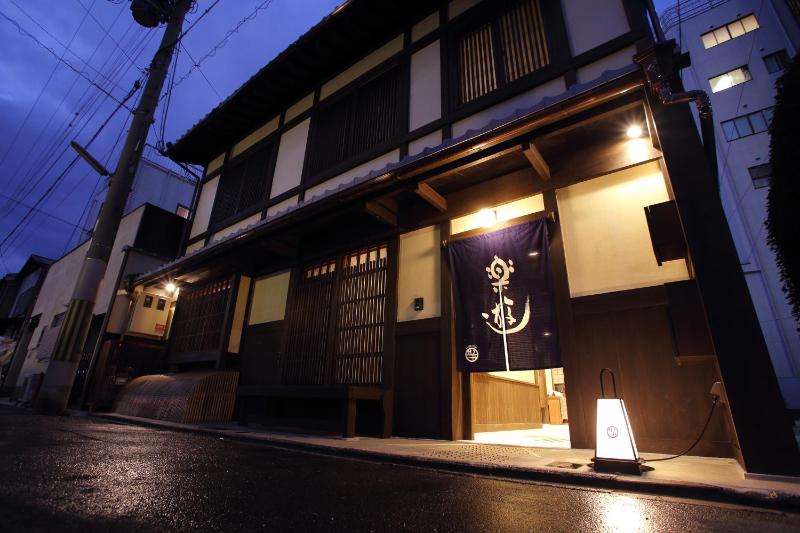
The Rest of Japan
Ryokan are most common outside of cities; in small towns, villages, the countryside and most commonly, around onsen. Combining an onsen experience and a ryokan experience is the best way to experience both. I also think that it is better, where possible, to choose somewhere where there are other attractions.
Below, I have listed areas that have great onsen, areas of interest and/ or places of great natural beauty, making them the best place to stay in a ryokan in Japan. It would be difficult to go to all of these areas in one visit to Japan, but these are the best place for ryokan in Japan.
Japan has four major islands (and thousands of smaller ones). The largest, which has Tokyo, Kyoto and Osaka on it, is Honshu. The northern most major island in Japan is Hokkaido, and the southern most major island is Kyushu. International travelers do not visit the fourth one, Shikoku, very often, as it is mostly rural and not so interesting for most visitors.
The Best Ryokan in Tohoku: North of Tokyo
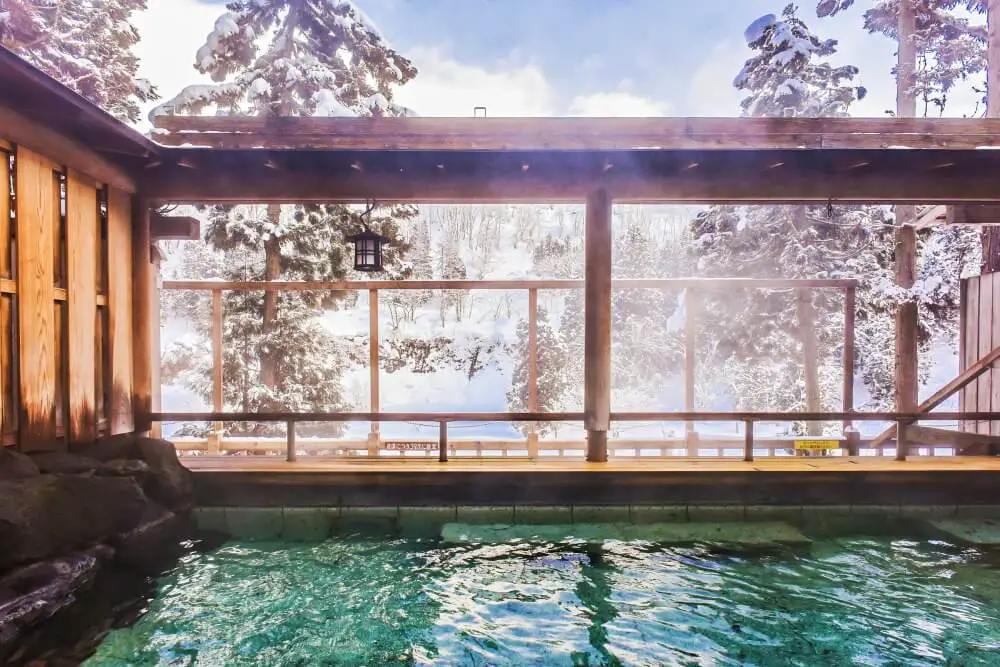
The northern part of Honshu is Tohoku. It is a mountainous area with woods, lakes, hiking trails and bears. It is the perfect place to relax, surrounded by nature, and enjoy some of the best luxury onsen in Japan.
CHIKUSENSO MT. ZAO ONSEN RESORT & SPA
Chikusenso is a large luxury resort with western and Japanese-style rooms available. It is surrounded by woods and near a crater lake.
As one of the best ryokan with private onsen, all rooms come with a private onsen, but there are also two public onsen for men (one outdoor and one indoor) and two for women (one outdoor and one indoor), as well as two private outdoor onsen that you can reserve for free.
There is a gym and spa, a rooftop lounge with a Zen garden, a bar, gift store and library.
Kaiseki dinners are available in the restaurant, as well as teppanyaki and even fugu (fugu is blowfish and it is poisonous if not prepared properly. Consequently, fugu chefs are specially licensed. The thrill that you might be eating something deadly makes it highly coveted and expensive.)
There is a free shuttle bus from Sendai Station. English is spoken. This is my pick for the best hot spring hotel in Japan.
STAR RATING: 5 stars
GUEST RATING: 9.5 – 9.9
LOCATION: Togatta Onsen, Mount Zao
PRICE: $$$ – $$$$$
PROS:
◊ After dinner, they give you a box of baked goods made by the chef.
◊ Spacious rooms.
CONS:
◊ Food receives mixed reviews with Japanese guests.
This is a classic luxury ryokan with 51 rooms. You can choose Japanese-style rooms, western rooms or a mix of both. Some rooms have private onsen, and there are also indoor and outdoor shared onsen.
Meals are served in their restaurant or in your room, and kaiseki, beef shabu shabu (literally ‘swish swish’ – you cook thin strips of marbled beef at your table by swishing them though hot water) and other Japanese meals are available.
There is a free shuttle bus from Hanamaki airport and Shin Hanamaki Station.
STAR RATING: 4.5 stars
GUEST RATING: 8.5 – 8.9
LOCATION: Hanamaki Onsen, Tohoku
PRICE: $$$ – $$$$
PROS:
◊ The food received positive reviews.
CONS:
◊ Not a traditional family-run ryokan with just a few rooms.
[maxbutton id=”4″ url=”https://www.booking.com/hotel/jp/kashoen.en.html?aid=1559357&no_rooms=1&group_adults=1″ text=”BOOK KASHOEN HERE” ]
TSURUNOYU ONSEN and YAMANOYADO
Tsurunoyu is one of the oldest and most famous onsen ryokan in Japan, dating from the 17th Century. The oldest building is a thatched row house. It is a rustic onsen with 30 rooms, most with shared toilets and all with shared baths. There are irori (sunken hearths with open fires) in some rooms.
There is a more modern sister hotel, Yamanoyado, about half a mile/ 1 km away and the rooms there have private bathrooms. The meals are good, but more basic than the multi-course gourmet kaiseki served in most ryokan. Dinners are served in your room unless you stay in Building 2 and 3.
The setting is beautiful, but the main reason people come here is for the onsen. There are four baths, each with different mineral compositions. It’s possible to book a small private bath, but there are also public baths for men and women.
The highlight, though, is the large mixed-gender outdoor bath. It can be disconcerting to be naked with both sexes together, especially when custom dictates that you don’t wear towels in the water. However, the water is milky and women can actually enter the water from a connected women’s bath and make their way partially submerged into the shared bath area. There are lovely views from the shared bath. (There are also partial views OF the shared bath from outside).
Note that the public baths are separate from the accommodations, so you have to walk outside to get to them.
STAR RATING: 2.5 stars
GUEST RATING: 8.5 – 8.9
LOCATION: Semboku
PRICE: $ – $$
PROS:
◊ Famous onsen baths.
CONS:
◊ Remoteness.
◊ Patchy reports of friendliness of staff.
◊ Accommodations are rustic with no ensuite facilities.

The Best Ryokan in Nagano
Nagano is most famous for the 1998 winter Olympics, and in winter, Japanese flock to the Nagano hills for skiing and snowboarding. In summer, there are hikes in the hills and, of course, onsen. It is also one of the best places in Japan to see snow monkeys. And enjoy staying in a ryokan. There are plenty of the best onsen ryokan hidden in the hill in onsen towns and surrounded by forests.
This 77-room luxury resort has private villas set on the banks of a river in the middle of a forest next to a lake, surrounded by mountains. You can do birdwatching, hiking, horseback riding, and morning yoga or enjoy the library, but the main reason to go there is to enjoy the hot springs.
There are bathtubs in the rooms, as well as a shared meditation bath that includes a dark room with no light, and both indoor and outdoor shared onsen.
The resort is modern, and the restaurant and bar are set on terraces and lit with fire lamps at night. Have a drink in the patio bar before enjoying a sensational kaiseki dinner and even fireworks. Western-style rooms and breakfast are available. There is a shuttle bus into town. (Limited) English is spoken.
STAR RATING: 5 stars
GUEST RATING: 7.5 – 7.9
LOCATION: Karuizawa-machi
PRICE: $$$$ – $$$$$
PROS:
◊ The kaiseki dinner gets very favorable reviews.
◊ The modern architecture is stunning.
CONS:
◊ The price.
◊ It is set in a forest, but there is also a parking lot and other buildings around, so expect that.
◊ Patchy service, which you don’t expect at this price.
One of the best onsen ryokan in Nagano, the 8-room Sui Suwako ryokan is a modern building with a small Japanese garden on the grounds. All of the rooms have views of Suwa Lake and have their own private outdoor onsen, but there is also shared mixed-gender onsen on the rooftop with a panoramic view of the surrounding area.
Breakfast and dinner and included, and are sensational. Meals are “performed” in your own private dining room at a time of your choosing. A multiple-course kaiseki includes horsemeat sashimi (raw horse). If you stay more than one night, other meal options are also available. Food is paired with different sake. There is also a separate sake bar.
A shuttle bus is available, and English is spoken.
STAR RATING: 5 stars
GUEST RATING: 9.0 – 9.4
LOCATION: Lake Suwa
PRICE: $$$$
PROS:
◊ Great views of Suwa Lake.
◊ Great meals.
CONS:
◊ The only access to the rooftop onsen is by stairs, which is not great if you aren’t very mobile.
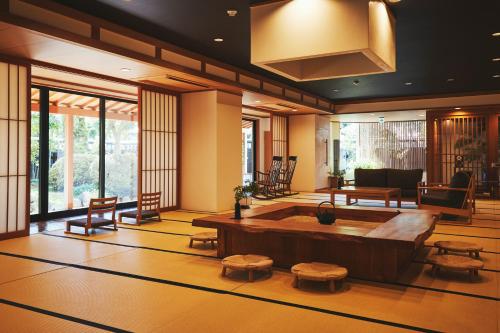
YUDANAKA SEIFUSO
This is a small family-run ryokan with 15 Japanese-style rooms. There are four onsen (fed by three different hot springs), including an outdoor shared bath, and indoor shared bath and two that can be reserved (free) for private use.
It has a great location near the snow monkeys and the staff can drive you to the snow monkey park in Yamanouchi. It’s a 2-minute walk from Yudanaka Train Station. Dinner is available in a private dining room and features local seasonal ingredients, including wagyu beef. Japanese-style breakfast is also served. Meals cost extra and need to be booked in advance.
The owner’s son speaks English (when he is there).
STAR RATING: 3 stars
GUEST RATING: 9.0 – 9.4
LOCATION: Yudanaka Onsen
PRICE: $ – $$
PROS:
◊ Very friendly staff.
◊ Location.
CONS:
◊ It’s a little shabby around the edges for some tastes.
The Best Ryokan in Takayama
I love Takayama and the surrounding Hida region. It is located in Gifu, in the mountains north of Nagoya. Takayama is one of the best onsen towns in Japan, with wooden houses and sake factories. Nearby is Shirakawa Go, a picturesque village famous for its thatched houses, and Hida Folk Village. It also has some of the best onsen ryokan in Japan.
This charming traditional onsen with just 8 rooms is set in a house that is over 180 years old plus three individual houses/ cottages, including a traditional thatched house. It has a beautiful setting in the woods next to a mountain stream and two onsen (both indoor, but with huge windows for views). But perhaps the main attraction is the beautiful irori (traditional sunken hearth) fireplace in the main house.
A “rustic” kaiseki dinner and breakfast (western is available on request) are included in the rate and are served in the restaurant, which includes some private dining rooms. After dinner a complimentary “sake service” is offered in the main dining room with sake heated in bamboo tubes in the open fire. Very limited English is spoken.
STAR RATING: 4.5 stars
GUEST RATING: 9.0 – 9.4
LOCATION: Hidatakayama Onsen, near Takayama
PRICE: $$$$ – $$$$$
PROS:
◊ The two onsen, including one with rocks surrounding the pool, giving it a cave-like feeling.
◊ The food receives rave reviews.
CONS:
◊ Service is patchy.
◊ It’s 20 minutes from the center of Takayama (but they will pick you up from the station).
◊ WiFi is only available in the main room by the fire.
This small ryokan is run by a very friendly couple. It has 6 rooms and 6 baths (two large outdoor baths, two large indoor baths, and two small indoor baths) that are not in the rooms, but are all designed for private use.
No reservations are needed and there is no time limit. The ryokan is only about 40 years old and the building is a simple wooden building with Japanese-style rooms, surrounded by trees.
Meals are served in the restaurant and there is a separate private room for families with young children. A simple kaiseki dinner includes seasonal local foods such as Hida beef, as well as local sake.
It is not a super luxury ryokan, but the simple fare, private onsen, wonderful location in the woods, and friendly hosts make this one of the best ryokan Takayama has in the mid-range price bracket.
English is spoken.
STAR RATING: 3 stars
GUEST RATING: 9.5 – 9.9
LOCATION: Okuhida Onsen, near Takayama
PRICE: $$ – $$$
PROS:
◊ 6 private onsen.
◊ Great views.
◊ Very friendly and helpful owners/ hosts who speak good English.
CONS:
◊ It is a little out of town (but the owner can pick you up from bus stop).
The decor of this ryokan is classically traditional, with lots of wood and Japanese art. There are three wings; the oldest is more than 100 years old and is a registered “National Tangible Cultural Property”. The 20 rooms all have views of the river. Japanese and western-style rooms are available. There is also a relaxation room with massage chairs and foot available.
In addition to the small bathroom with an outdoor tub in some of the rooms, there are two indoor onsen (for men and women) with views outside, a private bath that can be reserved for a fee and public outdoor onsen in the gardens – the men’s has a warm waterfall and the women’s is filled with roses. Free sake is served at the open-air baths until 7:00pm. Seasonal onsen are also available.
There are multiple meal options including a great kaiseki dinner with Hida cuisine, Hida-beef steak, sukiyaki and shabu shabu. There are complimentary aperitifs/ sake and a Japanese breakfast is provided. Meals are served in a private dining room.
There is free pickup from JR Furukawa station though Yatsusankan is only a short walk from the station. Basic English is spoken.
STAR RATING: 4 stars
GUEST RATING: 9.0 – 9.4
LOCATION: Hida Furukawa near Takayama
PRICE: $$ – $$$
PROS:
◊ The staff are friendly and helpful.
◊ Lovely views from the rooms.
◊ Unusual onsen.
CONS:
◊ No children under 13 (a con if you are traveling as a family).
The Best Ryokan in Hokuriku
The Hokuriku region is in the northwest of Honshu, along the Japan Sea (north of Takayama). A beautiful area with mountains, the sea, gardens, castles and woods and more of the best onsen ryokan Japan has.
Japanese and western-style rooms are available, with and without open air baths and some with views on to an inner garden. Over 200 kinds of yukata are available for women to choose from (there is a more limited selection for men) for you to wander around the streets. There are two outdoor onsen – one for men and one for women, fed by the Yamashiro onsen, which is more than 1,300 years old.
There is a private concert for guests each evening between 9:00 and 10:00pm. All meals are served in your room and they serve a wonderful kaiseki featuring local, seasonal ingredients. An a la carte menu is also available.
STAR RATING: 5 stars
GUEST RATING: 8.5 – 8.9
LOCATION: Yunogawa, Yamashiro Onsen
PRICE: $$$ – $$$$
PROS:
◊ Private concert.
◊ Plenty of meal choices.
CONS:
◊ The ryokan is a big building without much charm other than lobby and the rooms.
◊ No view from the onsen.
◊ Some rooms need refurbishment – ask for a renovated room.
KAYOTEI
The 10 rooms of this luxury ryokan are arranged in the style of a traditional tea pavilion. It’s surrounded by trees and gardens, next to a small river and gorge, in the shadow of a forested mountain.
The rooms all have mountain views and are decorated with antique furniture and gorgeous Japanese art and artefacts. Japanese and western rooms are available. Some rooms have an outdoor onsen; there is also a shared indoor onsen with enormous windows providing views outside to the forest.
The kaiseki is organic, so it’s a little different from a regular kaiseki meal, featuring seasonal, local ingredients. Meals are served in your room or in a private dining room.
English is spoken.
STAR RATING: 4.5 stars
GUEST RATING: 9.0 – 9.4
LOCATION: Yamanaka Onsen
PRICE: $$$ – $$$$$
PROS:
◊ The ryokan has connections with local artisans, so they can show you how they make paper, soba noodles and do wood turning.
◊ Rooms are large.
CONS:
◊ There is not much in town except for the onsen and artisans, so if you’re looking for more, this may not be your thing.
◊ It’s somewhat remote.
This beautiful 16-room family owned and operated onsen is a modern version of a traditional onsen on the site of a former temple. There are both indoor and outdoor shared onsen, as well as private outdoor onsen in all rooms. Japanese and western-style rooms are available.
There is a library, store and a separate tea ceremony room where you can participate in a tea ceremony. Meals are served in their restaurant and in addition to the traditional kaiseki, shorter, lighter meals are also available. English is spoken.
STAR RATING: 3 stars
GUEST RATING: 9.0 – 9.4
LOCATION: Kaga, Ishikawa, Yamashiro Onsen
PRICE: $$$$ – $$$$$
PROS:
◊ Multiple meal options.
◊ Beautiful art decorating the ryokan.
◊ Tea ceremony.
CONS:
◊ Meals are served in a restaurant (with tables close together) rather than your room or private dining room, as is traditional.
◊ Not all rooms are equal (guest staying one night tend to get worse rooms).
◊ Remote location (it’s one hour from Kanazawa). There is a shuttle from Kaga Onsen Train Station, but on schedule, not on demand, after 2:30pm only (check in is 3:00pm).
The Best Ryokan in Hakone, Japan
The best ryokan near Tokyo are in Hakone. Hakone can be visited as a day trip from Tokyo – it’s two hours by train – but since it has the best onsen ryokan near Tokyo, it would be a shame to miss out.
There are many ryokan here, but the best hotels in Hakone, Japan tend to be clustered in Gora, which is an onsen area in Hakone. You can see Mount Fuji from some parts of Hakone, and there is a ropeway that takes you up and into the hills. There is also a large fancy boat that crosses the lake. It’s a gorgeous area.
This top-rated ryokan, one of the best luxury ryokan Hakone has, is nestled amongst woods and gardens on the grounds of a former, Elizabethan-style, summer villa of the Imperial Family. It’s been recently renovated.
There are 39 rooms, including some with private open-air baths and others with wooden bathtubs. Gora Kadan is one of the best onsen ryokan in Hakone, with a communal onsen and another smaller onsen you can reserve for private use.
In addition to the onsen, there is a heated indoor swimming pool for laps and a gym. There is a lounge, store and a bar with karaoke. A kaiseki dinner and breakfast are served in your room or the restaurant. (Limited) English spoken.
STAR RATING: 4.5 stars
GUEST RATING: 9.0 – 9.4
LOCATION: Gora Onsen
PRICE: $$$$ – $$$$$
PROS:
◊ Great location in the mountains make this probably the best place to stay in Hakone.
CONS:
◊ The water in the in-room baths is not mineral spring water.
◊ Mixed reviews on food.
This 20-room ryokan is one of the best ryokan in Hakone with private onsen. Many rooms have private open-air baths. There are also shared indoor and outdoor onsen for men and women (they are swapped at different times), plus a small outdoor onsen that can be reserved for private use, making this one of the best Hakone ryokan onsen. Japanese and western-style rooms are available.
A seasonal kaiseki dinner that is heavy on seafood is served in a private dining room. Japanese and western-style breakfast is available. (Limited) English is spoken.
STAR RATING: 4.5 stars
GUEST RATING: 9.0 – 9.4
LOCATION: Gora Onsen
PRICE: $$$$ – $$$$$
PROS:
◊ One of the best ryokan around Tokyo for its beautiful location.
CONS:
◊ No vegetarian meals are available.
◊ The western breakfast does not get great reviews.
◊ Not all rooms have views.
Another contender for the best onsen hotel in Hakone, Yamanochaya is surrounded by woods and a river. You walk across a wooden footbridge to get there. It has 15 rooms, including 4 with open air baths. There is also a large shared outdoor onsen that you can reserve for free for 45-minute timeslots, plus two indoor onsen. Japanese and western-style rooms are available.
A seasonal kaiseki meal (heavy on fish), included in the rate, is served in a private dining room. The Japanese breakfast changes daily. Another thing that makes this one of the best places to stay in Hakone, Japan is the aromatherapy massage that you can get – either in their spa or in your room. English is spoken.
STAR RATING: 4 stars
GUEST RATING: 9.0 – 9.4
LOCATION: Tounosawa Onsen.
PRICE: $$$ – $$$$$
PROS:
◊ A beautiful building in a nice location.
◊ Has one of the best private onsen in Hakone.
CONS:
◊ Most rooms have views of the mountain, but one room overlooks a power tower.
◊ The food and staff get mixed reviews.
◊ Some people complain that it is a little worn down.
◊ It’s a bit out of the way, up a steep hill from the town. Not good if you have mobility problems or heavy luggage.
The Best Ryokan, Izu Peninsula
The Izu Peninsula is a beautiful part of the country a side trip from the direct route between Tokyo and Kyoto. It has a stunning coastline, with beaches, waterfalls, sea caves and, of course, some of the best onsen in Japan.
This traditional ryokan is a tranquil, private place designed for quiet enjoyment and rejuvenation. The low-ceilinged building is made from traditional materials, wood, paper, soil, etc. and lighting is dim, as it traditionally was.
It is one of the best onsen ryokan Izu Peninsula has. There are two outdoor public onsen that are alternated between men and women, where you can enjoy the beautiful garden while soaking your cares away. Some of the 15 rooms also have an outdoor or semi-outdoor private bath.
A traditional Kaiseki dinner and Japanese breakfast are included in the price. There is a western-style lounge and bar area upstairs. (Limited) English is spoken.
STAR RATING: 5 stars
GUEST RATING: 9.0 – 9.4
LOCATION: Shuzenji Onsen
PRICE: $$$$ – $$$$$
PROS:
◊ Large rooms.
◊ Very clean
◊ Great service.
CONS:
◊ Not much to do other than relax.
Sanyo-so is a huge property dating from the Kamakura era. It has 36 (Japanese and western-style) rooms spread over two main buildings. There are two simple indoor and two outdoor public onsen (one of each for men and women) plus some rooms have private onsen.
The main reason for this ryokan’s fame, however, is the huge ‘four seasons’ garden with waterfalls and streams designed by famous garden designer Jibe Ogawa in 1929.
Kaiseki dinner and traditional Japanese breakfast are included in the price and served in your room. English is spoken.
STAR RATING: 5 stars
GUEST RATING: 7.5 – 7.9
LOCATION: Izunagaoka Onsen
PRICE: $$ – $$$$
PROS:
◊ The famous garden.
CONS:
◊ The public onsen is modern and simple, but if you are looking for bells and whistles (spa, sauna, multiple temperatures or water types), then it will disappoint.
◊ You need to walk quite a bit due to the size of the gardens.
Located in Shuzenji, where there is a famous temple, the 24 rooms of Arai Ryokan are scattered around 15 buildings, which are collectively national registered cultural assets. You will wander through corridors, over a wooden covered bridge, around koi-filled ponds, along the Katsura River and through gardens to get to your room or the onsen.
There are two shared indoor onsen in a bathhouse more than a century old, one shared outdoor onsen in the garden and two private baths, one of which you pay a fee to reserve.
The Arai has been in operation since 1872 and the attention to detail remains. The kaiseki dinner features local and seasonal ingredients. Both dinner and breakfast (Japanese or continental) are served in your room. Vegetarian meals are available on request. (Limited) English is spoken.
STAR RATING: 4 stars
GUEST RATING: 9.0 – 9.4
LOCATION: Shuzenji Onsen
PRICE: $$$ – $$$$
PROS:
◊ Good location in the center of town.
◊ Beautiful buildings and setting.
CONS:
◊ The rooms Can be cold.
◊ Patchy service.
The Best Ryokan in Kyushu

Steam rising over Beppu from the hot springs
Kyushu is the southern-most of Japan’s four main islands and many people don’t make it here, but Japanese people travel far for the hot springs.
Indeed, Beppu is one of Japan’s most famous onsen resorts. There are gardens, canals, castles and sensational scenery to fill your time, but after all that activity, Kyushu is the perfect place to lie back and enjoy traditional Japanese hospitality. Here are three top ryokan in Kyushu.
Kannawaen is a beautiful modern hotel with 30 Japanese and western-style rooms available. It is one of the best ryokan in Beppu. It’s in the middle of town, close to everything, but creates a secluded environment of ponds, beautiful gardens and multiple buildings, including separate villas, a thatched teahouse and a Noh theater where you can watch performances.
There are outdoor and indoor shared onsen, plus private onsen in your room. Meals are served in their restaurant and include kaiseki and teppanyaki featuring seasonal, local ingredients.
STAR RATING: 4.5 stars
GUEST RATING: 9.5 – 9.9
LOCATION: Beppu
PRICE: $$$ – $$$$$
PROS:
◊ Large rooms.
◊ Spotlessly clean.
◊ Great location in town.
CONS:
◊ Not as traditional as some ryokan.
Another contender for best onsen ryokan in Kyushu, the Showaen is small family-owned traditional onsen ryokan with 11 rooms. You enter through a pretty entrance and along a path to get to the ryokan, which includes a tea ceremony room. Nearby there is a bridge over a waterfall and a trail to a lookout over the city. It is also near the “Rakutenchi” amusement park, and the ryokan provides free tickets.
There are two public baths (one for men and one for women), plus a private outdoor bath that you can reserve for free. There are also open-air baths with views in some rooms and bathtubs in other rooms. Note that the shower and change areas are outside, which is cold in winter.
The kaiseki dinner, which sometimes includes fugu (puffer fish, a potentially deadly delicacy), comes with a Japanese-English menu list so you can easily understand all of the dishes. Meals are served in your room. There is a free transfer from the train station. English is spoken.
STAR RATING: 3.5 stars
GUEST RATING: 8.0 – 8.4
LOCATION: Beppu
PRICE: $$$ – $$$$
PROS:
◊ Staff were very polite and friendly.
◊ Big rooms.
CONS:
◊ Some rooms seem a little dated.
◊ Mixed reports on cleanliness.
16 beautiful Japanese-style rooms with a relaxed ambiance in the middle of a forest. Several of the rooms come with private stone or outdoor baths (or both) and there are two separate villas in addition to the main house.
In addition, there are two outdoor shared onsen and two indoor shared onsen (one each for men and women) plus three private baths (cypress, stone and open-air bath) and a foot bath, which you can reserve for an hour, with lovely views.
The exotic kaiseki (think horsemeat sashimi) is served in their restaurant. The breakfast is Japanese. No English is spoken.
STAR RATING: 4 stars
GUEST RATING: 9.0 – 9.4
LOCATION: Kurokawa Onsen
PRICE: $$$ – $$$$
PROS:
◊ Very quiet and tranquil area of Kurokawa (a mile or so from the center of town; there is a free shuttle and free parking).
◊ Lovely onsen and lots of them to choose from.
◊ Spacious rooms.
CONS:
◊ No WiFi in rooms.
◊ No place to shower at the public baths.
◊ The service is patchy.
◊ It can be cold at night in winter.
◊ The kaiseki is a little too adventurous for some palates.
The Best Ryokan in Hokkaido
Hokkaido is the most northern of Japan’s four main islands. In spring and summer, it is cool and the flowers are bright splashes of color in the fields. In winter, there is an incredible snow festival in the main city Sapporo, where enormous ice sculptures are created. Relaxing in hot springs and soaking in hot water surrounded by snow is pure bliss. And what better place to do that than a ryokan?!
So, what’s the best ryokan Hokkaido has?
AKAN TSURUGA BESSO HINANOZA
This is a high-end luxury boutique ryokan with fewer than 30 rooms and is arguably the best onsen ryokan in Hokkaido. All of the rooms have private outdoor onsen, and there is also a communal onsen on the roof with lake and mountain views.
It’s located right by Lake Akan and it’s just a short walk to Akanko Onsen, Akandake-jinja Shrine and Ainu Kotan Folk Village. The rooms are either completely Japanese style (futons) or a combination of beds and futons.
A kaiseki meal and Japanese breakfast are included in the price and served in their restaurant. This is a great place to unwind, but is not for families – no kids are allowed. (Somewhat limited) English is spoken.
STAR RATING: 5 stars
GUEST RATING: 9.0 – 9.4
LOCATION: Kushiro
PRICE: $$$$ – $$$$$
PROS:
◊ Large rooms all with private outdoor onsen and separate living area.
◊ Great location on lake.
CONS:
◊ Price. You pay for the luxury and comfort. If price is a consideration, then this ryokan is not the best choice.
Another contender for the title of best onsen hotel in Hokkaido, this boutique ryokan is modern, but maintains many ryokan traditions. There are only 15 rooms, each individually decorated and set slightly apart from each other. Each room comes with two private onsen – one indoors and one outdoors.
There is also a communal onsen in the garden. The ryokan is surrounded by woods, which makes for nice views from the rooms (ask for a room with a forest view; other rooms look out on to meadows – also not a bad view).
Meals are served in private rooms in the dining room and the usual elaborate kaiseki is included, as well as western- or Japanese-style breakfast. There is a tea ceremony in the afternoon, a library, a cigar room, spa with massages and open fireplaces in the communal lounge.
STAR RATING: 4.5 stars
GUEST RATING: 9.5 – 9.9
LOCATION: Kutchan-cho
PRICE: $$$$$
PROS:
◊ The private onsen in your room.
◊ The level of service.
CONS:
◊ Yukata are not provided (though pajamas are).
◊ Most rooms are western-style with beds (this could be a pro, but personally, I like a ryokan that is fully traditional with futons).
A medium-sized traditional ryokan with 35 rooms. Kaiseki dinner and breakfast are served in your room. There are communal onsen (outdoor and indoor). They alternate bathrooms between men and women each day, so if you stay for two days you will get to experience both onsen. English is spoken.
STAR RATING: 4.5 stars
GUEST RATING: 8.0 – 8.4
LOCATION: Yunokawa Onsen, Hakodate
PRICE: $$ – $$$$
PROS:
◊ Great service.
◊ Large rooms.
◊ Parking is available.
CONS:
◊ No private onsen in rooms.
◊ WiFi is in the lobby only.
◊ It’s a little far out of town. If you don’t have a car, it can be hard to get to.
Enjoy your ryokan experience!
Do you have any other ryokan that you would recommend? I’d love to hear about them. Comment below.
If you liked this post, please share the love and Pin It to your Japan board!
Read other Japan posts:
- Your Complete Guide to Staying in Traditional Japanese Guesthouses
- A guide to cherry blossom viewing in and around Osaka
- A guide to visiting Saiho-ji Moss Temple in Kyoto
About the author

James Ian has traveled to 82 countries and all 7 continents. He is passionate about experiential travel, i.e. meaningful travel that actively engages with the environment and culture. He helps people have similar experiences that involve active participation in activities and festivals; engaging with the local food and handicrafts through lessons and food tours; and interacting positively with environment by hiking, riding, rowing, diving and low/no impact animal encounters.
Travel Collecting is a participant in the Amazon.com Services LLC Associates Program, an affiliate advertising program designed to provide a means for sites to earn advertising fees by advertising and linking to amazon.com. Amazon and the Amazon logo are trademarks of Amazon.com, Inc. or its affiliates. As an Amazon Associate I earn from qualifying purchases.

